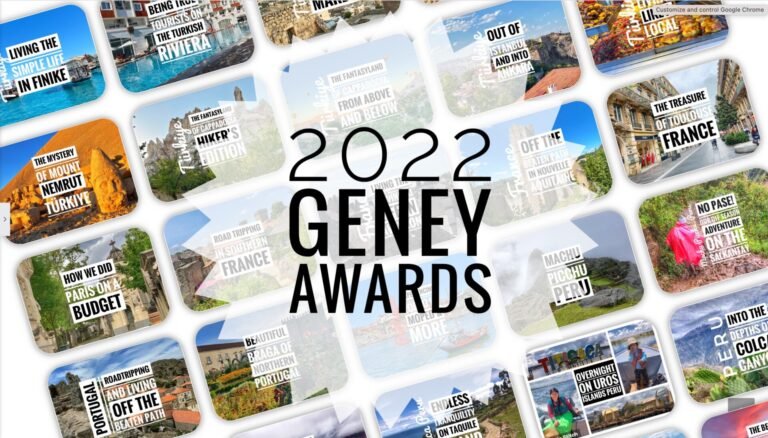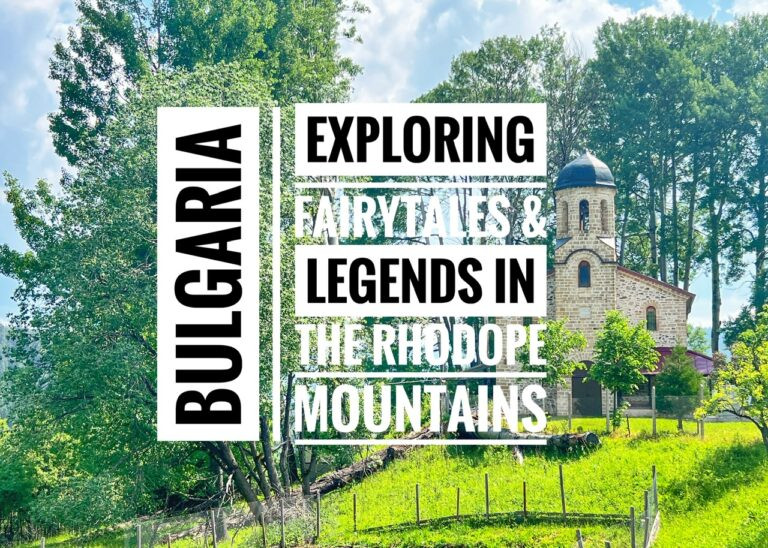
Getting to East Borneo
Once again, our carbon footprints were presented with a choice for our jaunt to the far east side of Borneo…a ~25 hour bus ride to Sandakan from Miri, or $87 for two flight tickets. This one had a 7-hour overnight layover obstacle in Kota Kinabalu, but according to the Priority Pass lounge app, it was open 24 hours so we figured we could nab some zzz’s in there. But, alas… surprise! The lounge was not open 24 hours so we slummed it like (frosty cold) peasants for our first overnight airport experience in years. Whoohoo! Now THIS feels like traveling!
Getting further and further from the equator and closer to the Philippines. (The tip of Palawan island is due north). When we were planning to come in 2020, we explored crossing these waters east to Zamboanga by ferry and learned they’ve been subject to illegal maritime activities since the pre-colonial era and even up to recent years. This has included modern day piracy, trafficking and kidnappings! Uh….we’ll stick with the plane?


Anyhow, after a three hour loungeless wait in Miri (because they didn’t have one…boohoo, poor journeymen), we took our 50-minute flight to Kota Kinabalu and arrived to this lounge at 11 pm. This was enough time for Greg to grab a beer and his customary midnight snack, noodle soup. This is obviously a joke because our normal bed time is 10.
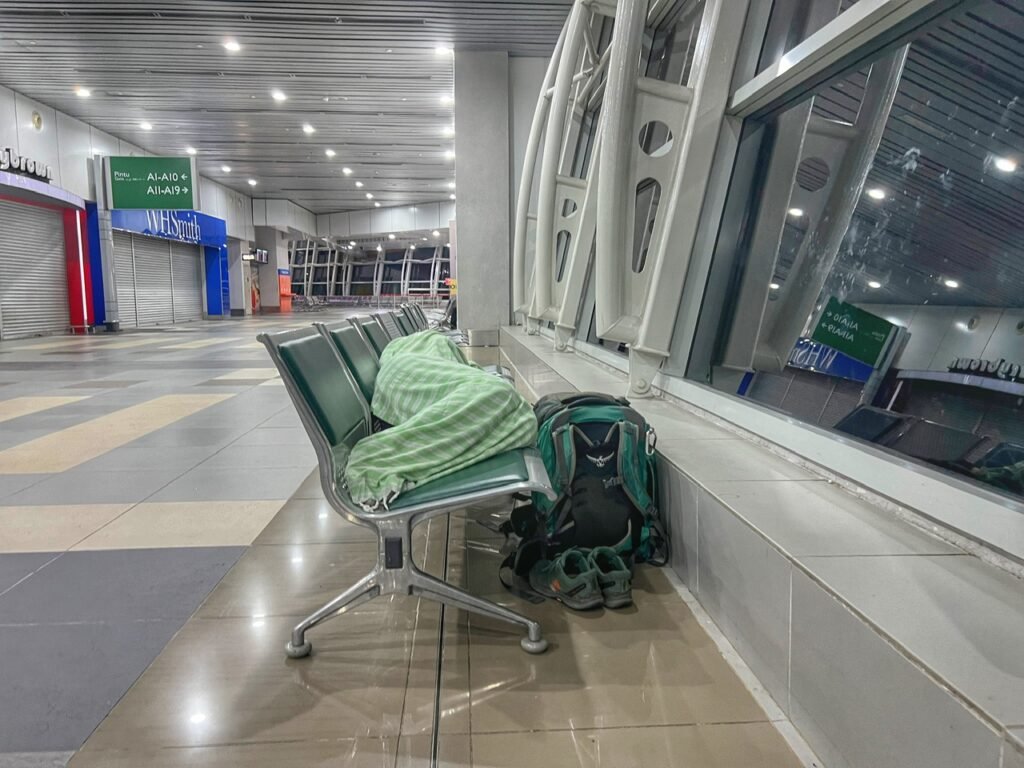

The “Travel Club” then kicked us out at midnight into a completely desolate airport where we got intimate with these graciously arm-rest free seats. Or…this was at least the gratitude exercise Mandy was practicing, along with glorifying the silence while endlessly squirming and trying to sleep at 2 am. It was also FREEZING so we broke out our puffy coats, sleep sheets, towel blankets, cubes filled with clothes for extra cushion against the icicle covered rigid metal, and of course, fillo pillows. At least living in your backpacks and traveling carry on, you’re always ready for any scenario! Needless to say, these scenarios are getting a little…uh…more challenging…as we age.
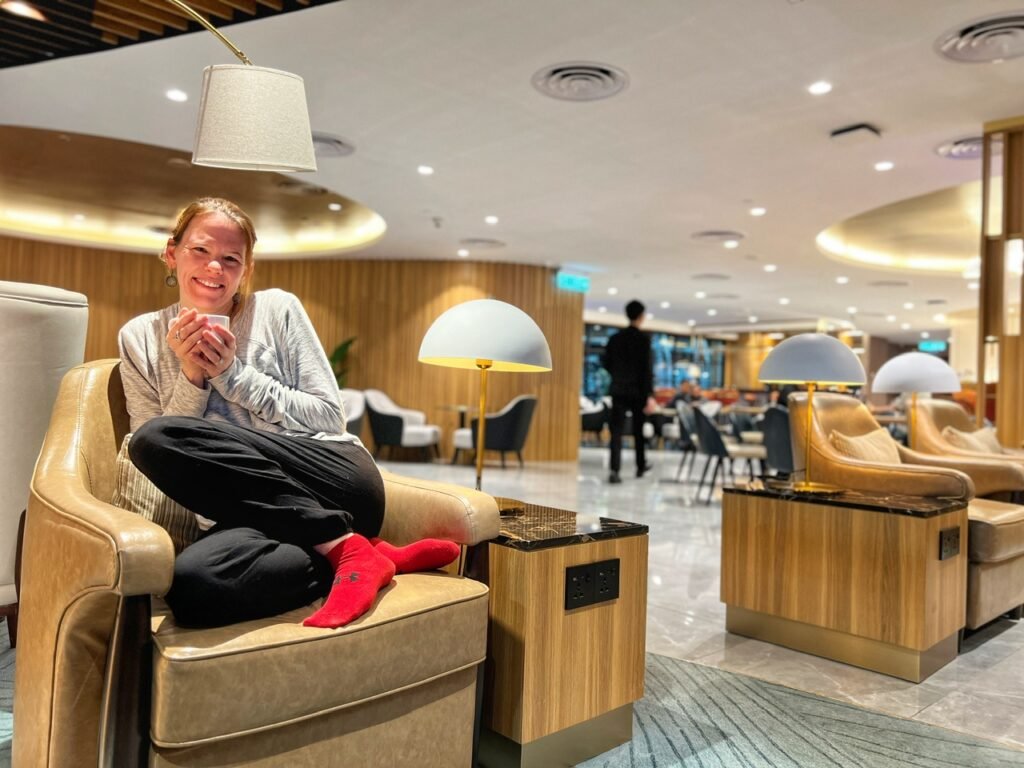
At 4 am, we were allowed to reenter the lounge and defrost our icy mittens around a latte.

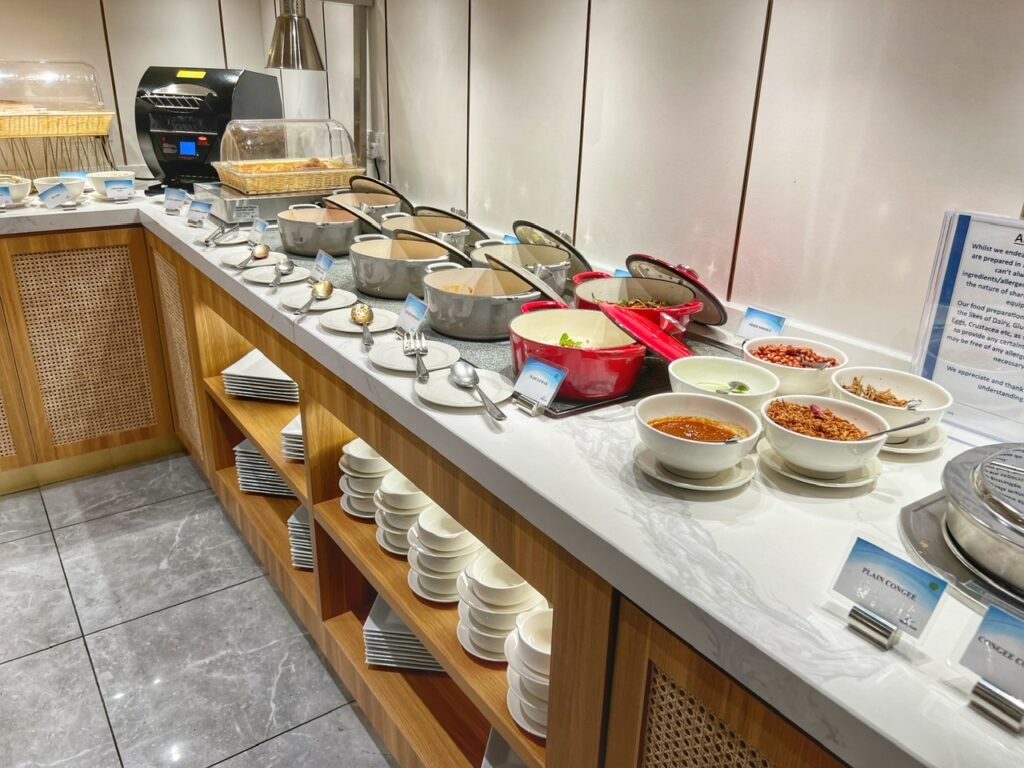
We honor you, beloved barista robot. And of course, before we left at 5:45, we also had to hoover in as much food as possible.

Greeting dawn, we climbed aboard our 6:25 flight…
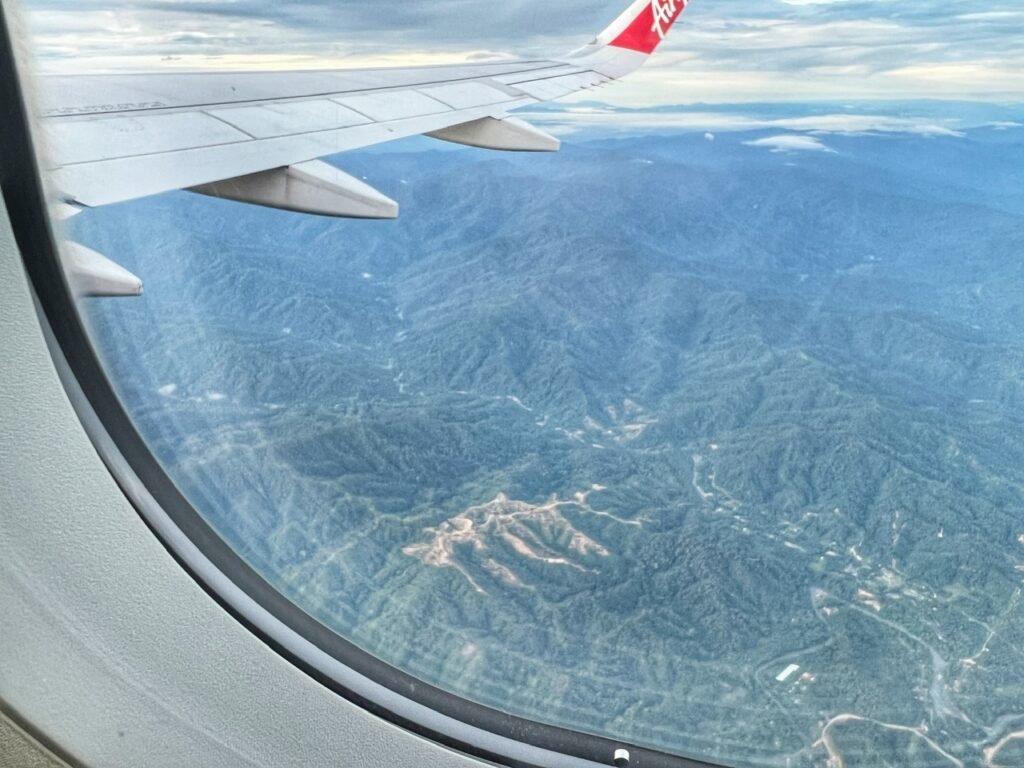

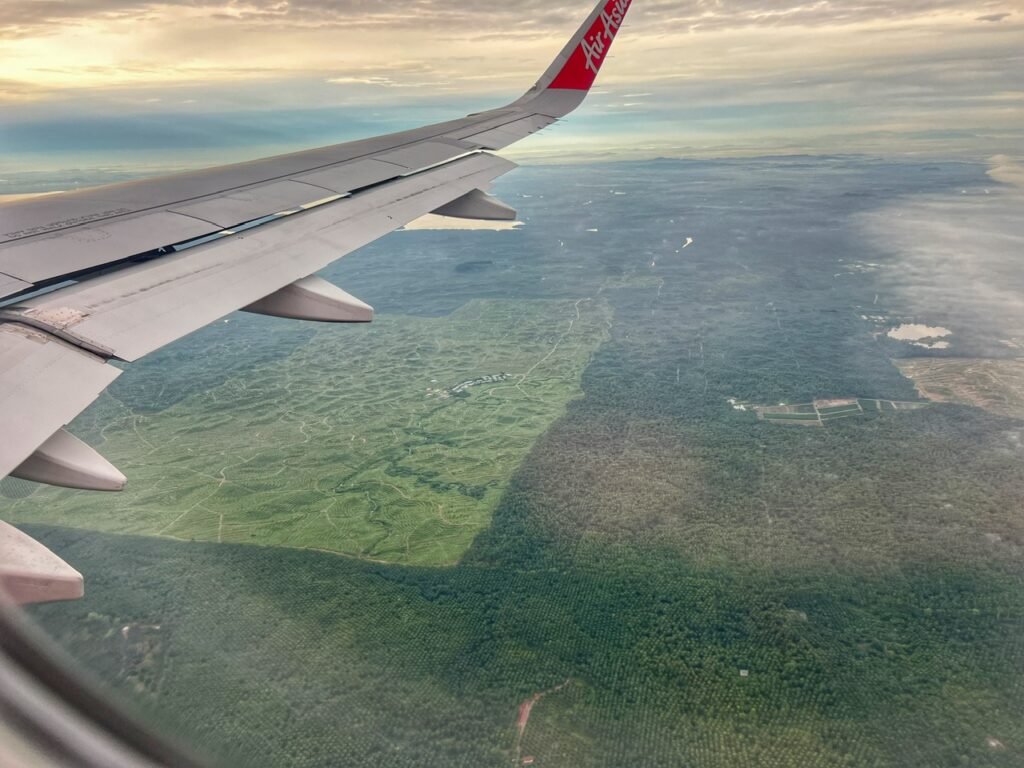
…which would again take 50 minutes, and sail us over some tremendous Bornean landscape, including snaking rivers and Mount Kinabalu in the distance. It also would let us see firsthand the devastation of clear cut forest used for palm oil plantations. After the war, timber trade flourished with wood being exported from Borneo all over the world and once they destroyed their lush resources, it became ground zero for the palm oil industry. Quite sad.

A 45-minute $5 Grab ride later, we arrived at 8 am to our hotel in Sandakan, AeCotel where they let us check in early for an extra $5 a night, making the total $28. Curling in our separate twins, we happily obliged and slept a lot of the day away.
The Sublime…and…Gritty…Sandakan
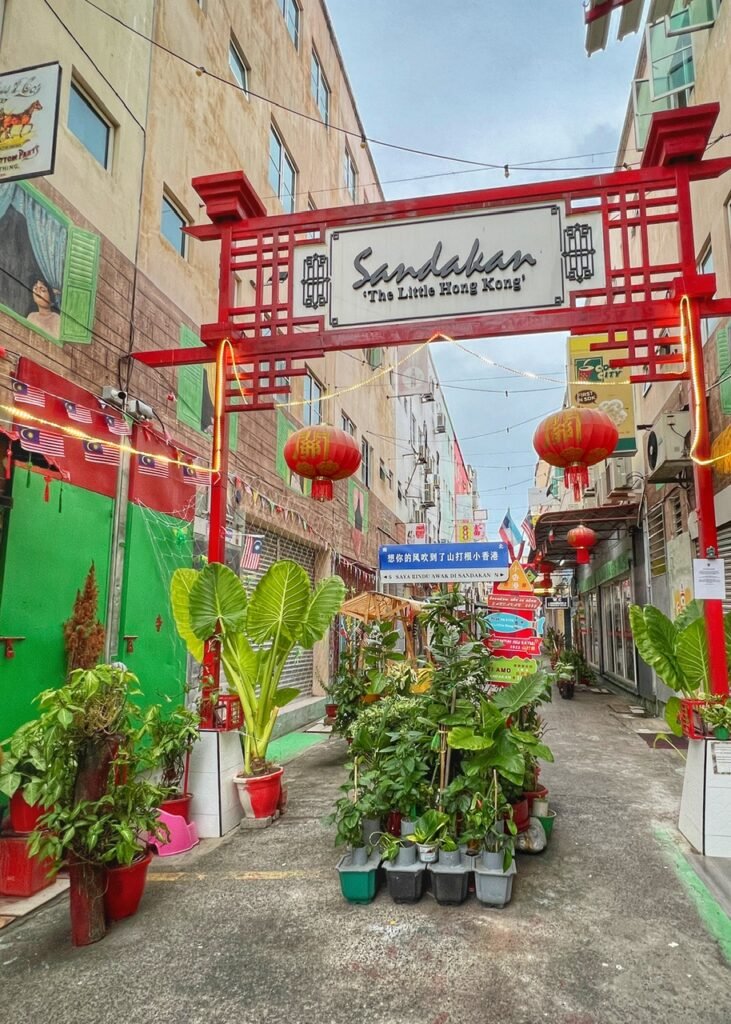
When we arrived to Sandakan, we were in zombie form from our night ‘o fun in Kota Kinabalu airport so we didn’t really register much until we went out later in the day. And our immediate impressions of the town? Uh… it’s a bit gritty compared to the places we’d seen in Sarawak and the locals also had quite a different vibe. We later found out that many locals had moved out of the center and many who remained where immigrants from other parts of Southeast Asia. They recommend staying between Mile 4 and 6 rather than in the center should you decide to visit.
According to Lonely Planet, Sandakan used to have much more charm, but sadly it was wiped to the ground during WW2 by the British in an attempt to shake off the invading Japanese.
Regardless, we managed to find some interesting tidbits during our two nights there, including some striking street art, a decent waterfront, and the opportunity to learn about great American author, Agnes Keith and see her 20th Century Bornean home.
Creative Lane, pictured above, is a work in process art alley that certainly gives a snapshot of how full of life Sandakan was in its glory days from the 1960s-90s when it was known as “Little Hong Kong.”
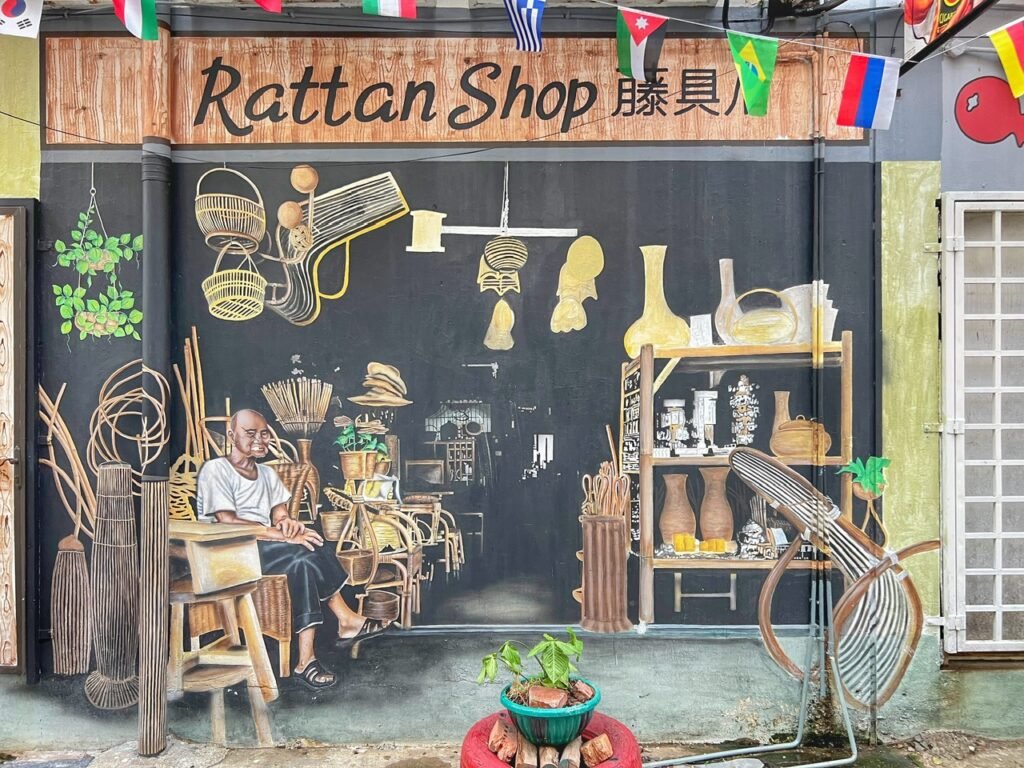

It’s nice to see local artists are trying to breathe life back into the city. Love the cute kitty at the bottom!

That said, it’s obvious that since its development, there has been a lack of maintenance, which can be witnessed by the faded and tattered umbrellas strung overhead.
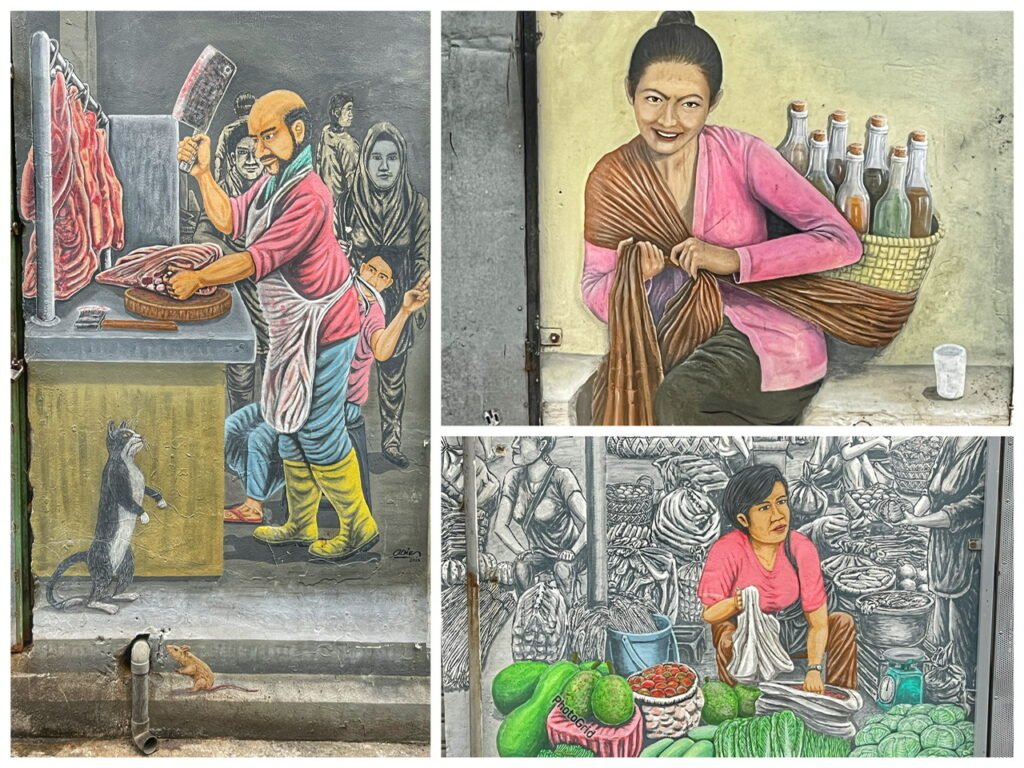
But someone cares, as exhibited in the beautiful local art.

Other than this facade, nearly everything on the street was shuttered so it simply felt desolate.
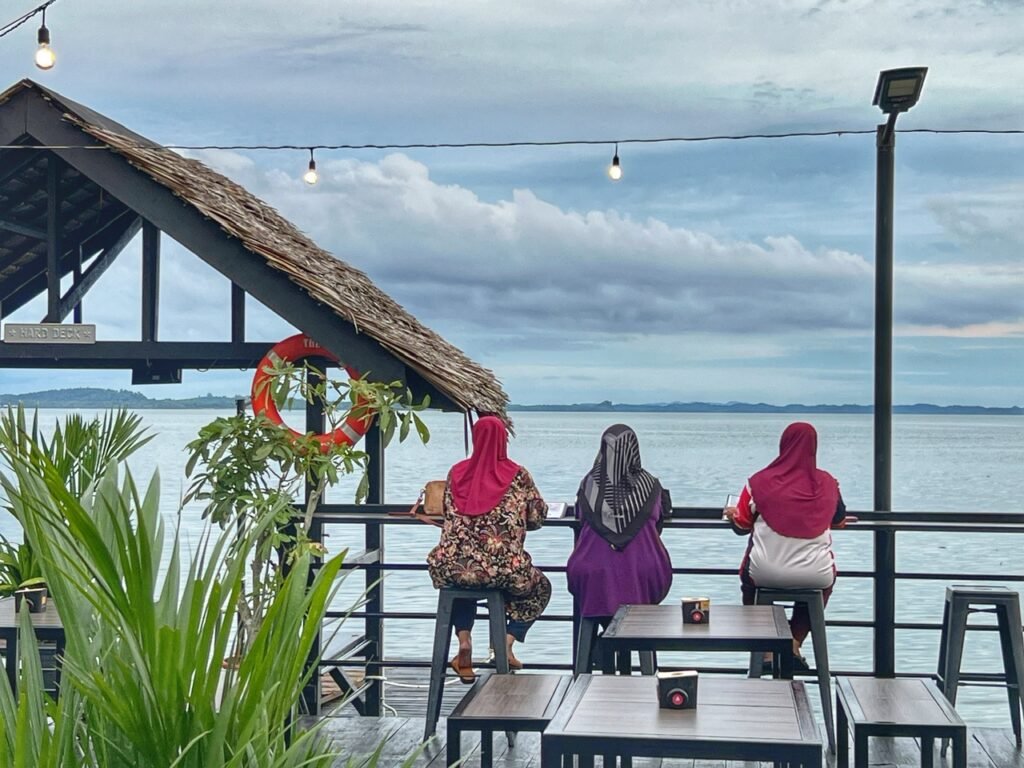
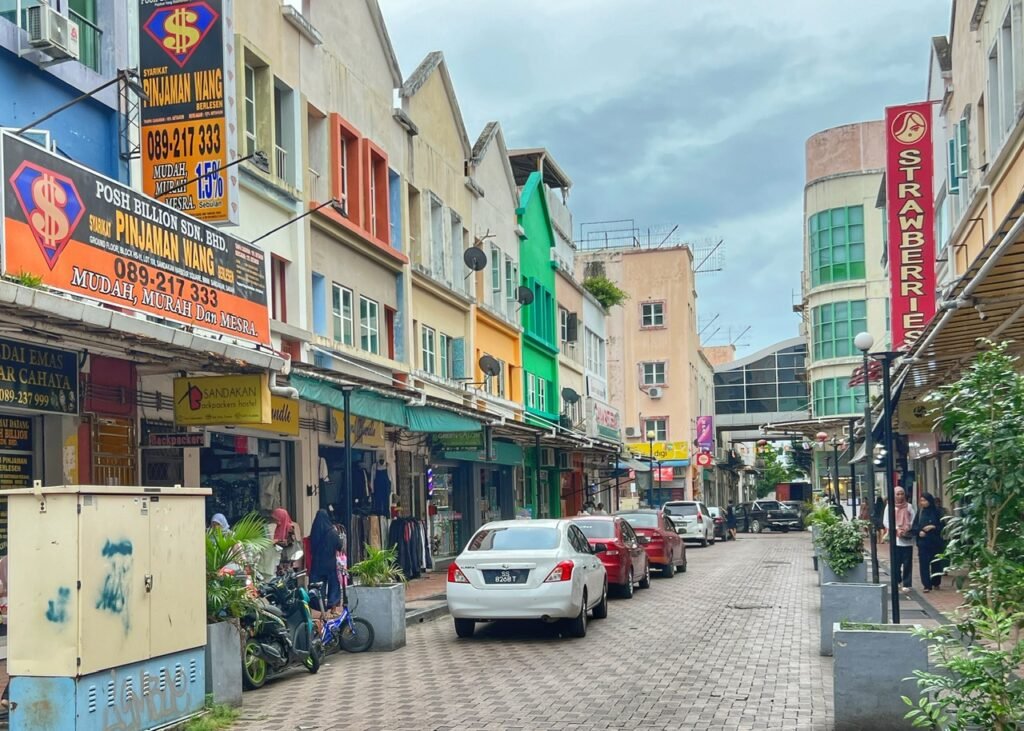
A trio of ladies enjoy some tea on the waterfront near one of the prettier areas of the city.

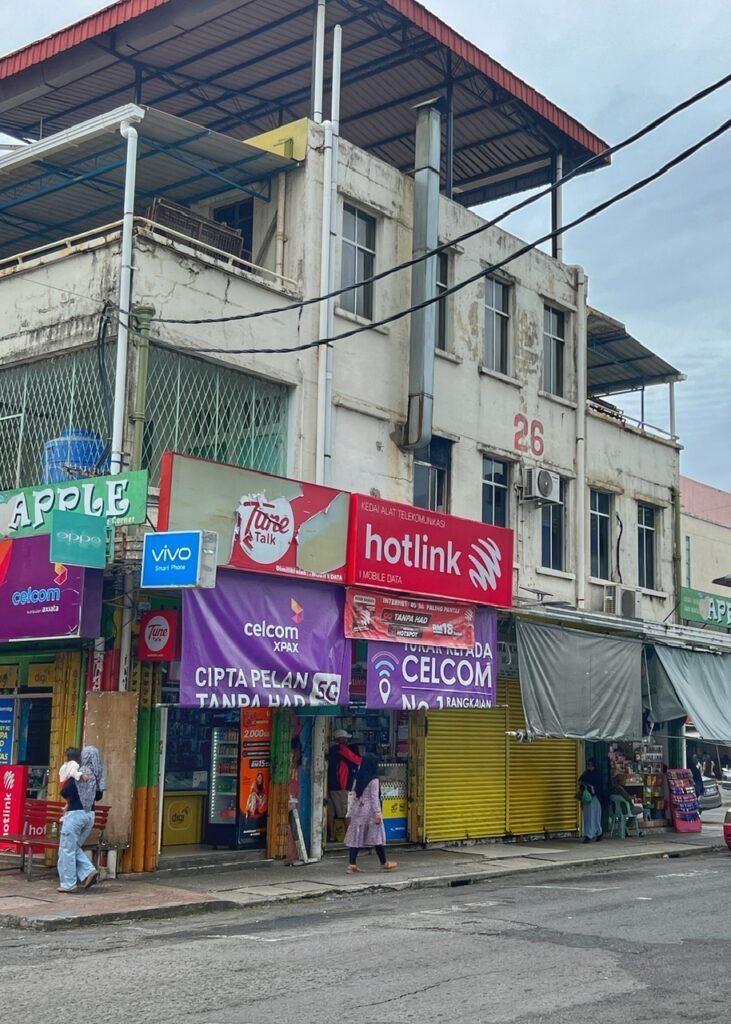
Mostly, the skeletons that remain through the city seem dilapidated and tired.
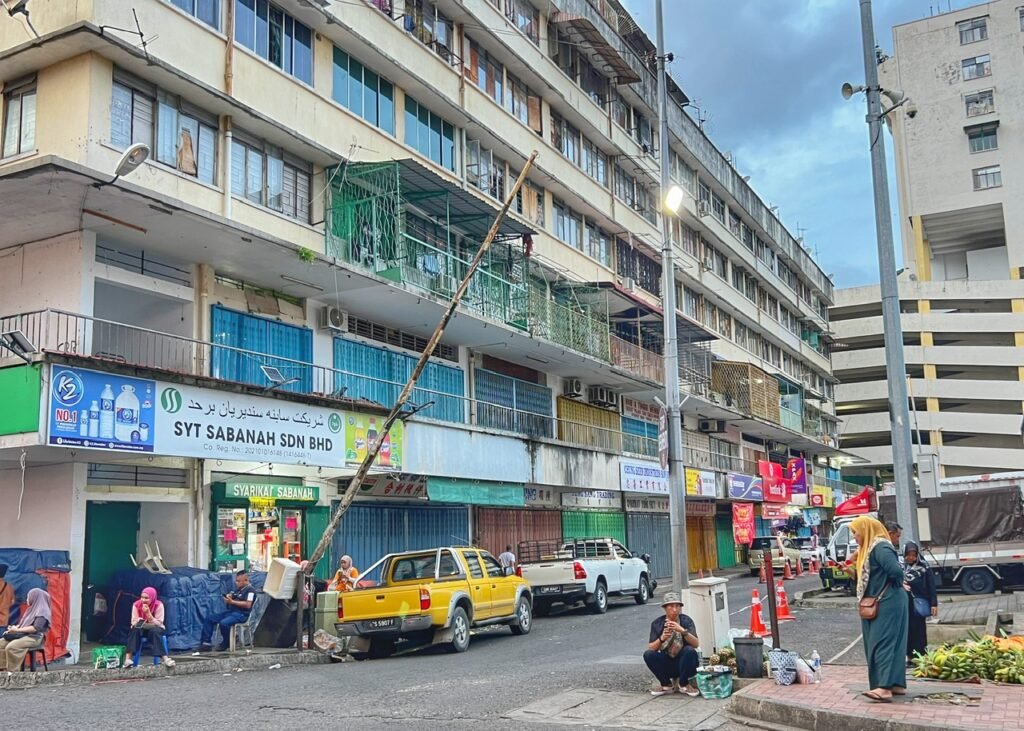
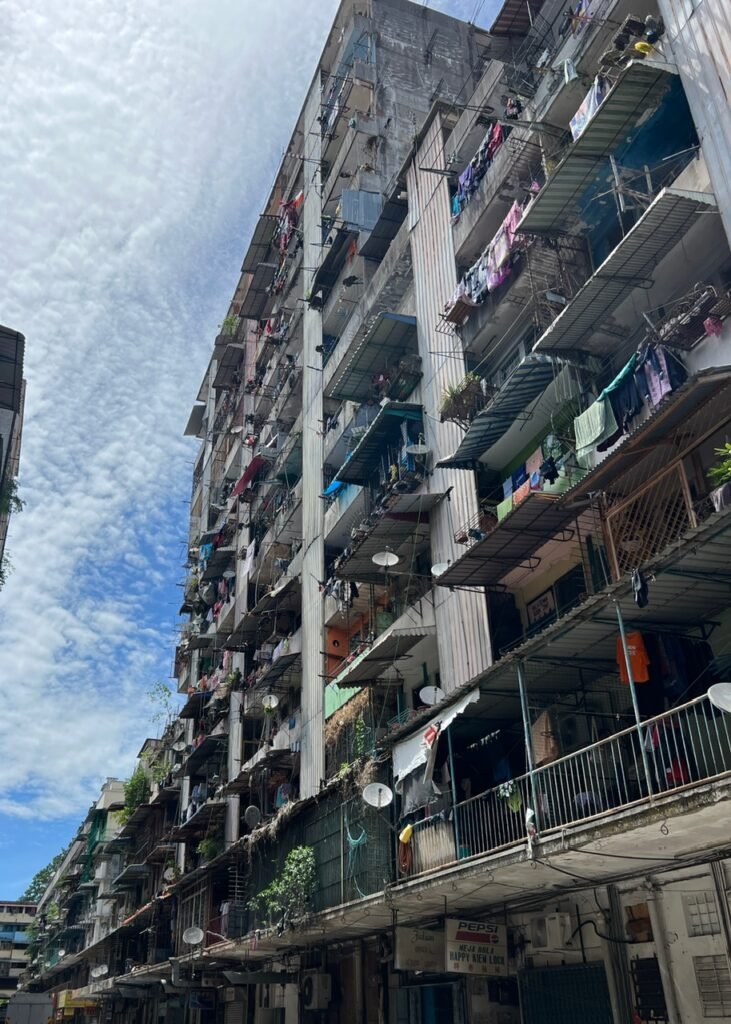
It’s a real indication of how the place you live can affect your outlook on life because the people also had a different vibe. Some scenes here even felt reminiscent of some poorer Central American cities.
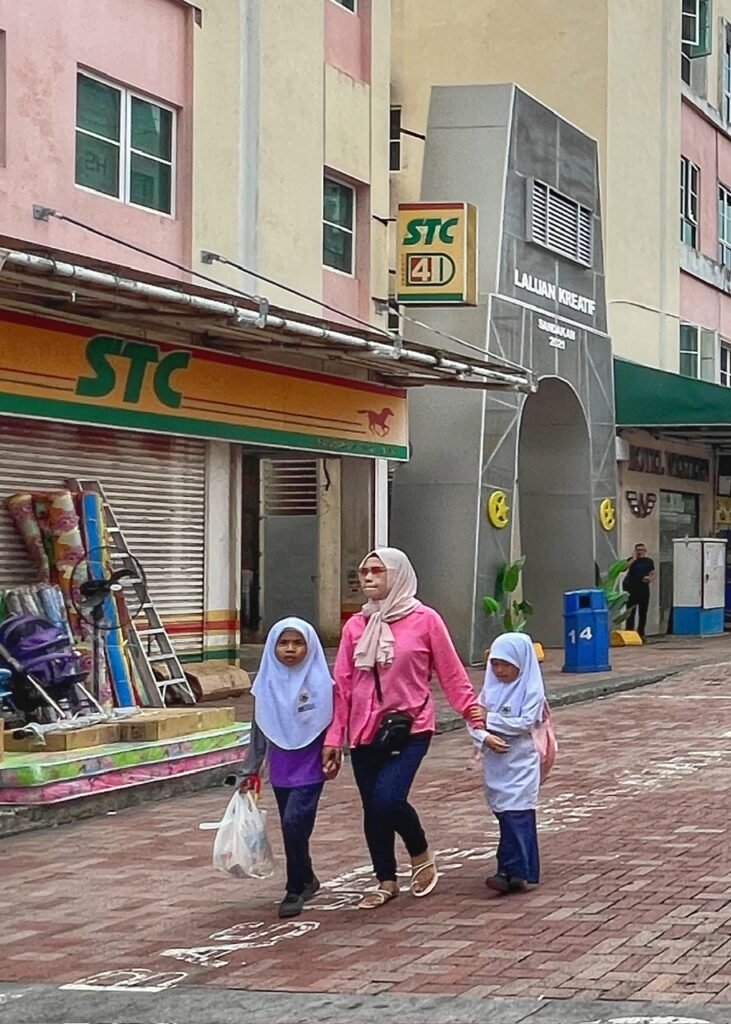
A local family walking down the street.
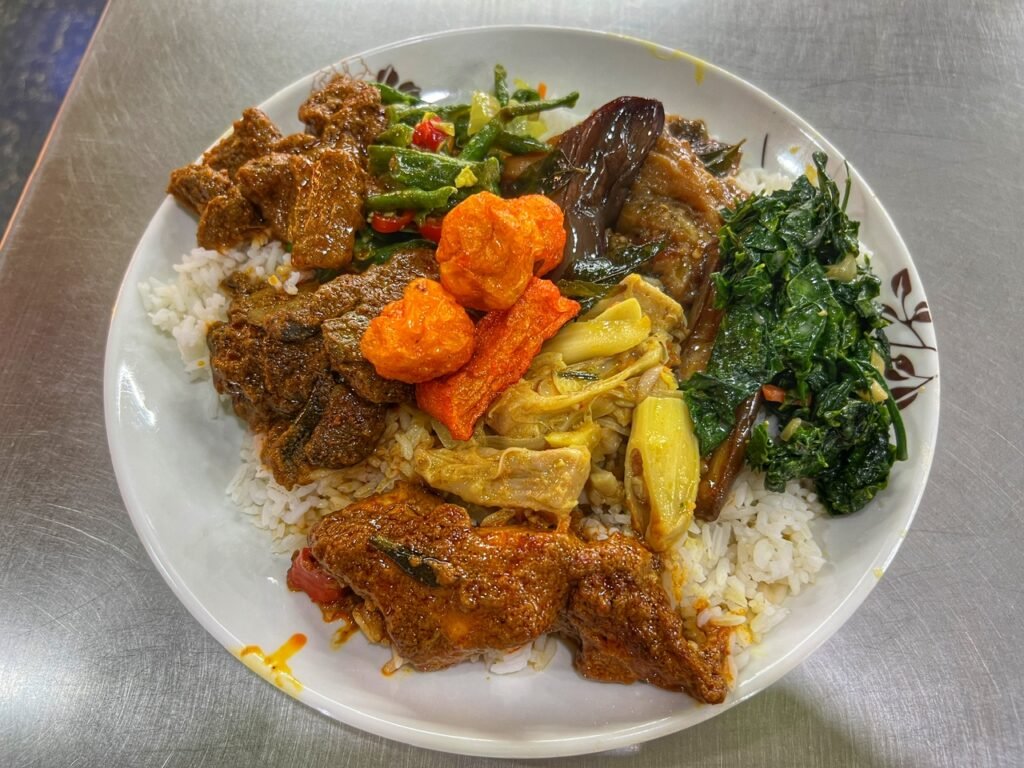
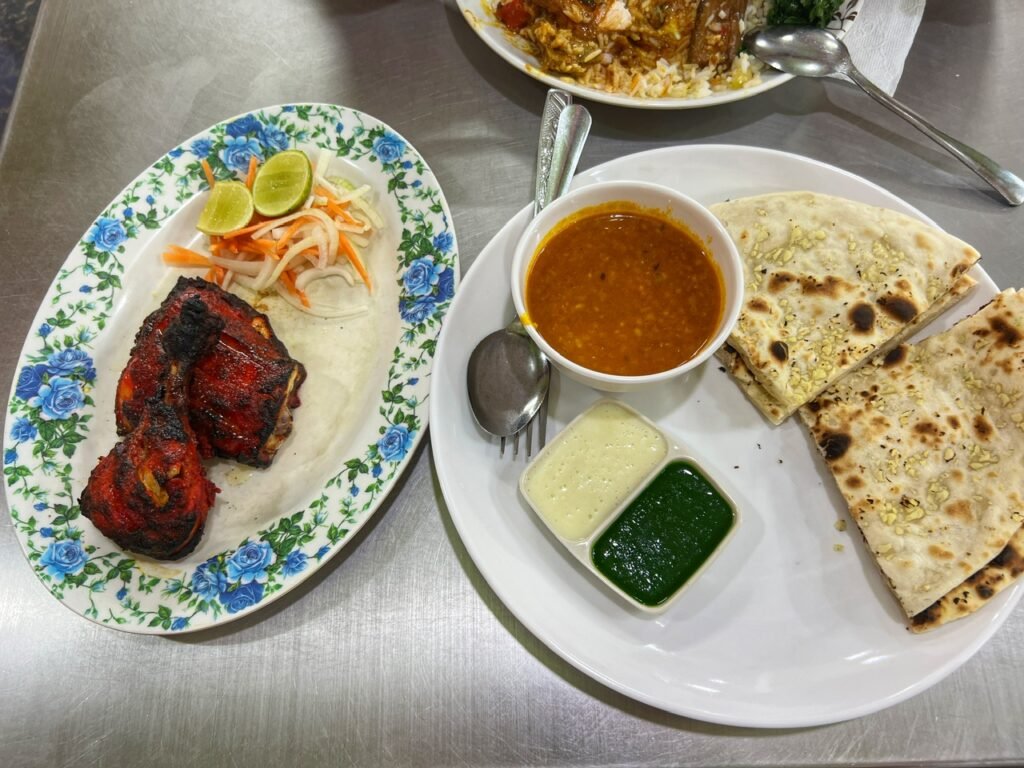
The food was decent, but it definitely didn’t seem to have the depth of Sarawakan cuisine, or perhaps we’re just tiring of this type of food and craving freshness. This local buffet was about $5 at Restaurant Mauzin, which also seemed quite overpriced. Foreigner special? Mandy’s tandoori chicken with garlic naan was about $3. Her motto is when you can’t go fresh, you go Indian.

The local shopping mall trying to market fashion abayas.

Globally appreciated street art.

This street art is dedicated to the Sandakan Death March. During this tragic World War II event, the Japanese forced more than 1,000 Allied prisoners of war to march from Sandakan to Ranau. The march covered a distance of approximately 260 km, and the prisoners were subjected to appalling conditions, including starvation, dehydration, and torture.
Many of the prisoners were already in poor health due to their imprisonment, and the grueling march proved fatal for the vast majority. Those who were too weak to continue were either shot or left to die, while the survivors were held in prisoner-of-war camps, where many more died from disease, malnutrition, and mistreatment. More disgusting examples of what man is capable of. And the story continues…
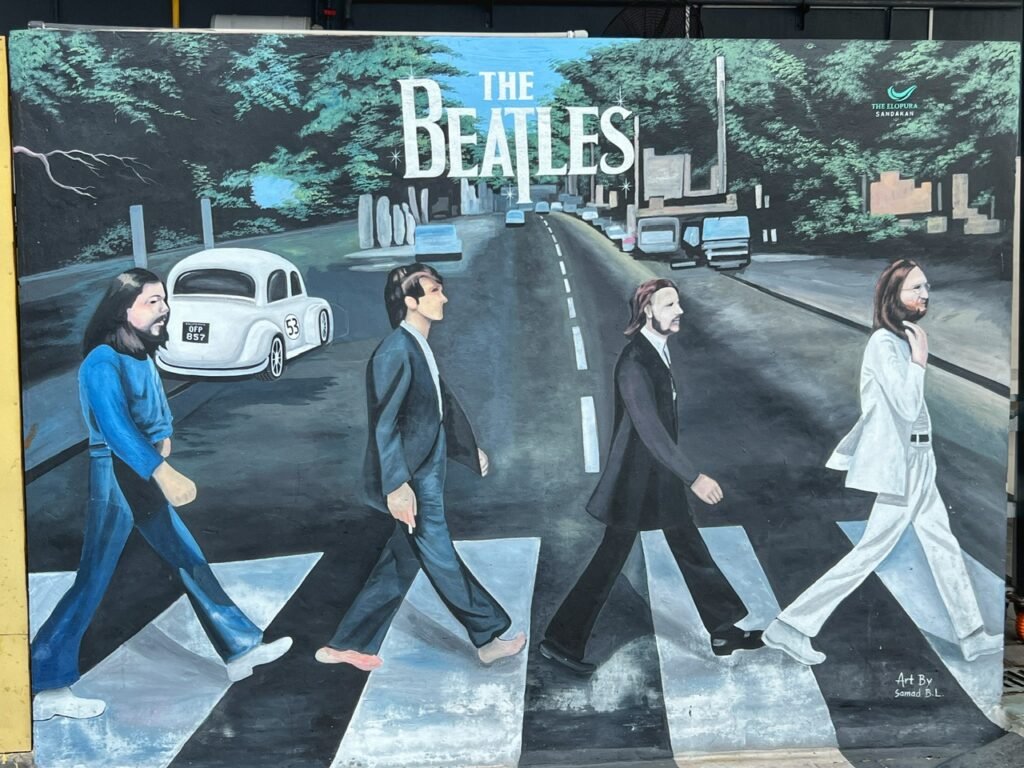
A happier march…Sandakan’s interpretation of the Fab Four.
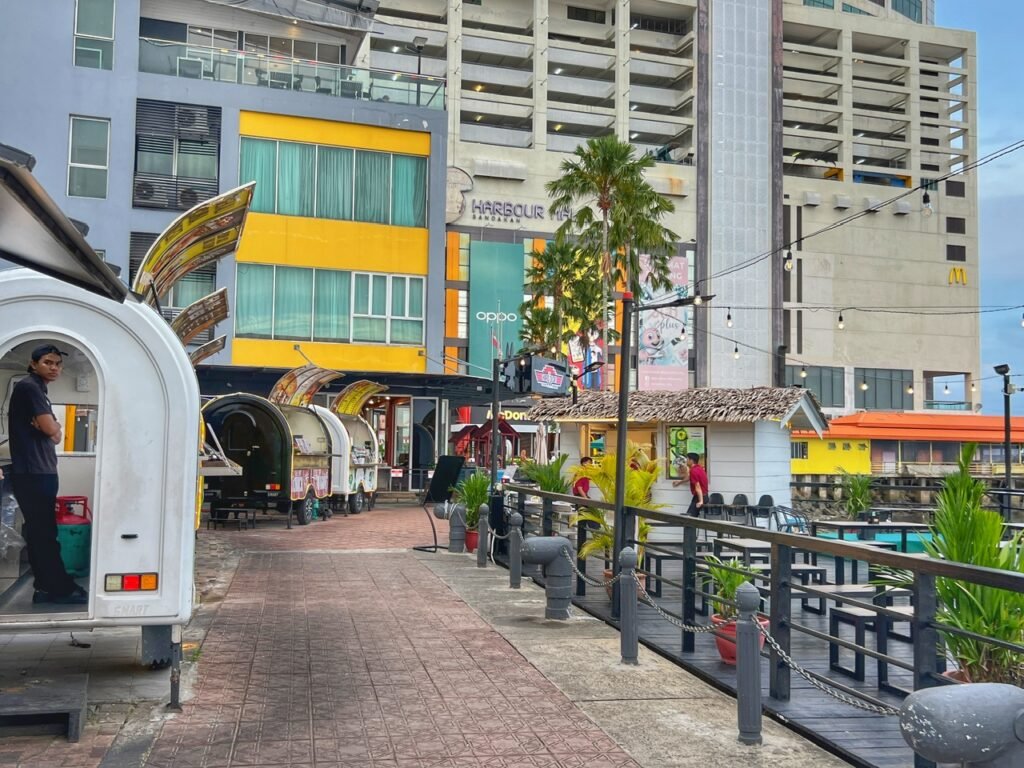
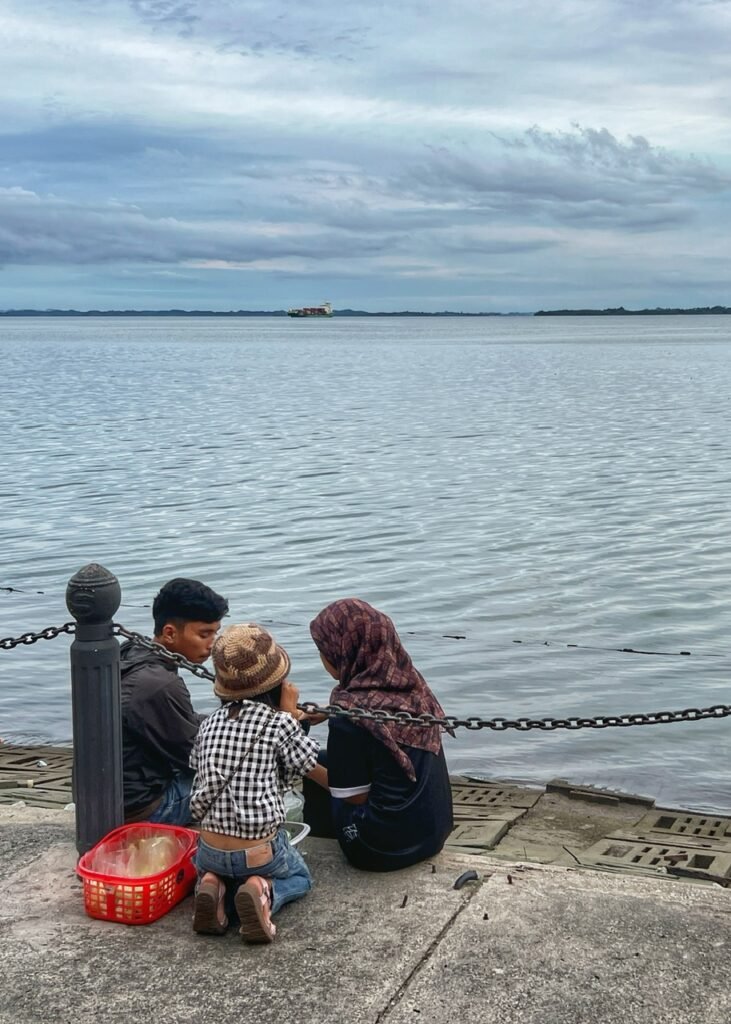
Food cart pods along the waterfront, as well as local kids gathering at the waterfront. Unlike in Kuching, they seemed more cautious towards us. Greg also got hit with a coconut on his back from a balcony. We still don’t know if this was an accident or intentional, but no one apologized nor did anyone nearby react when it happened. Sabah, at least this part, feels like we’re in a different country than we were in Sarawak State.

The reason most tourists, like us, end up in Sandakan…the gateway to the orangutans.
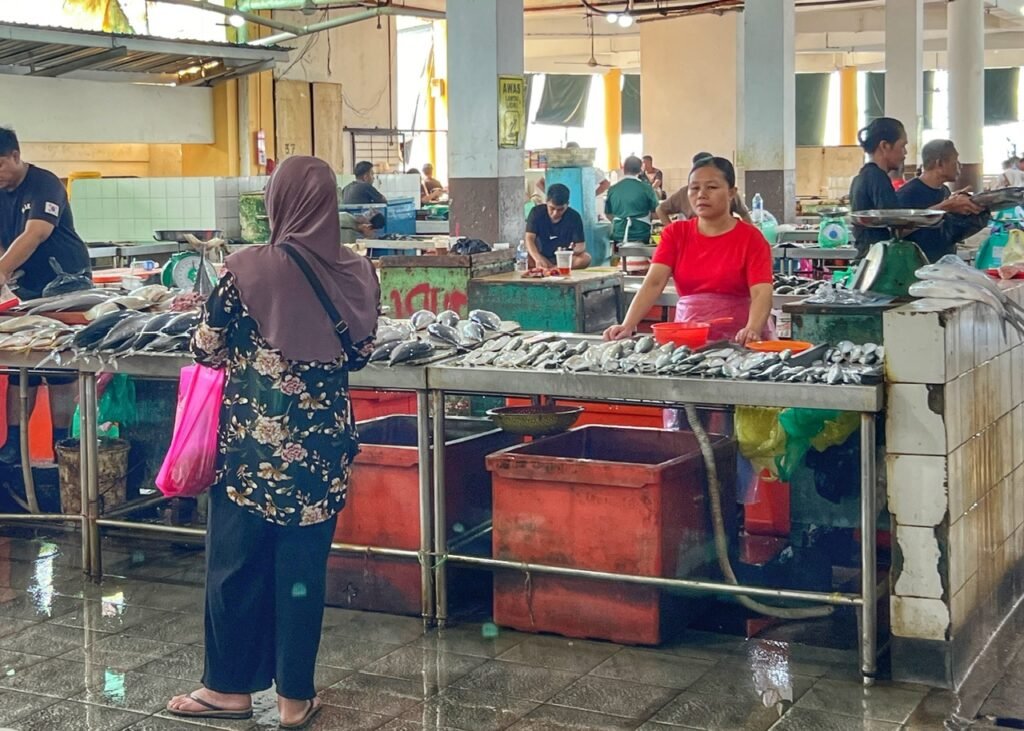
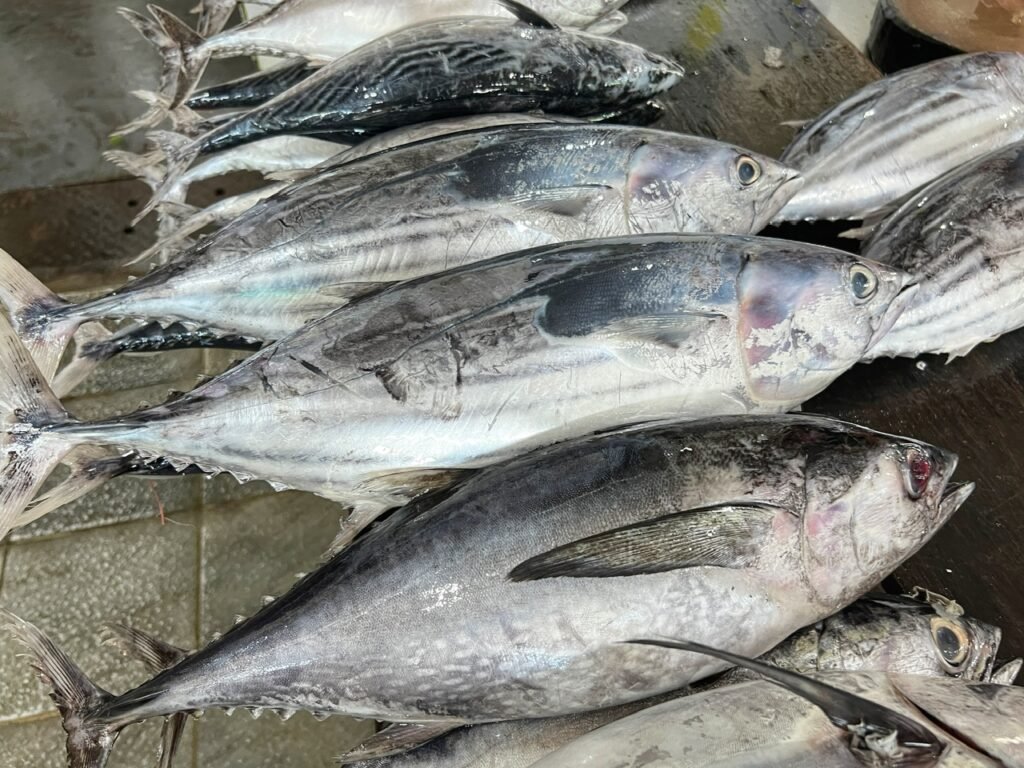
But we’re still glad we got to see real life…such as this local fish market. We talked to one of the vendors for a few minutes and couldn’t believe the sorry size of his tuna…about a foot in length which evolves from overfishing.
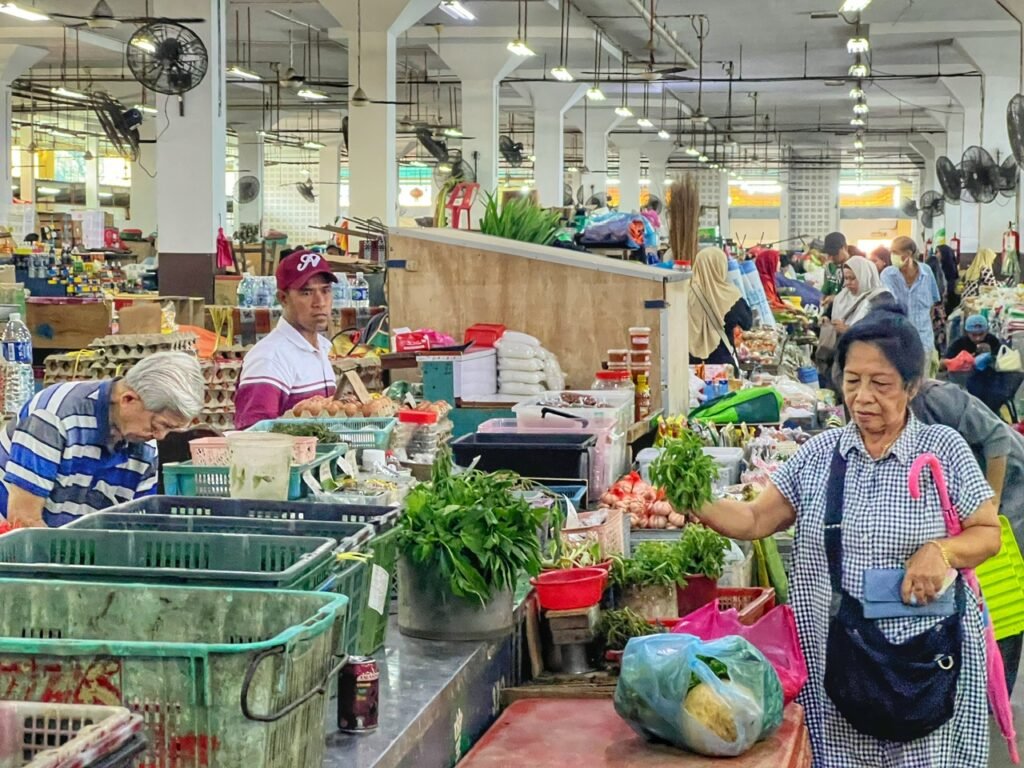
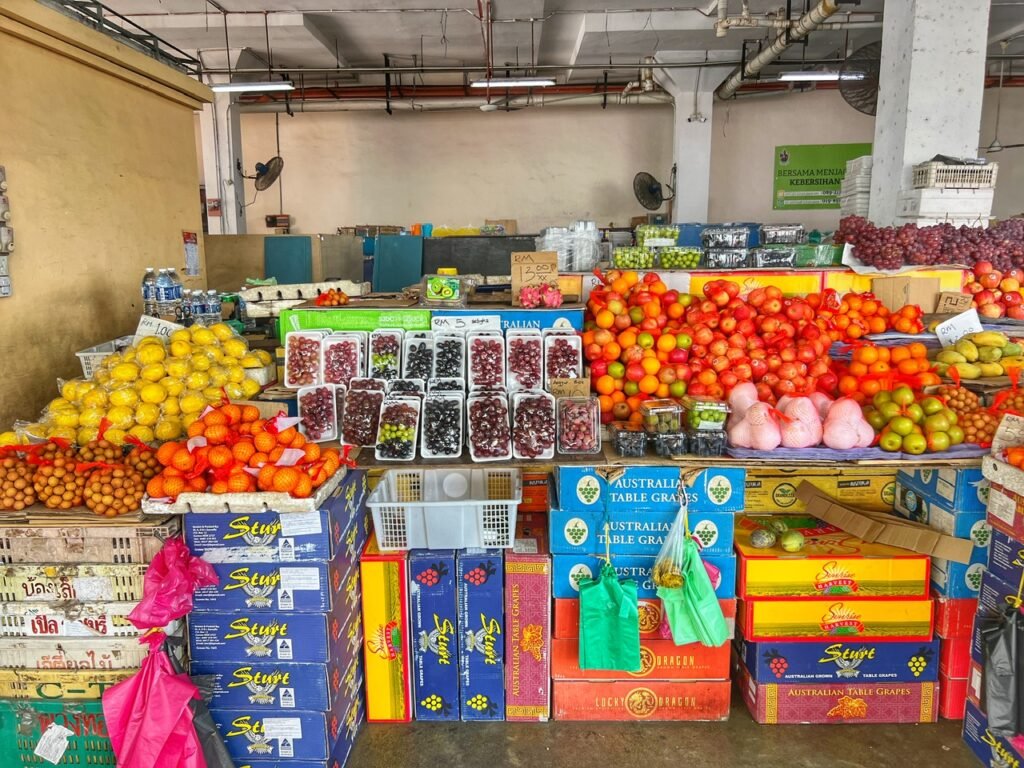
Sights of the central market. Some of the fruit looked like Christmas fruit in the States…a smattering of apples, oranges, lemons and grapes, all from Australia and few of which are local tropical fruits. This is really strange. Why aren’t they selling more local fruit at the local market? Something is going on here.
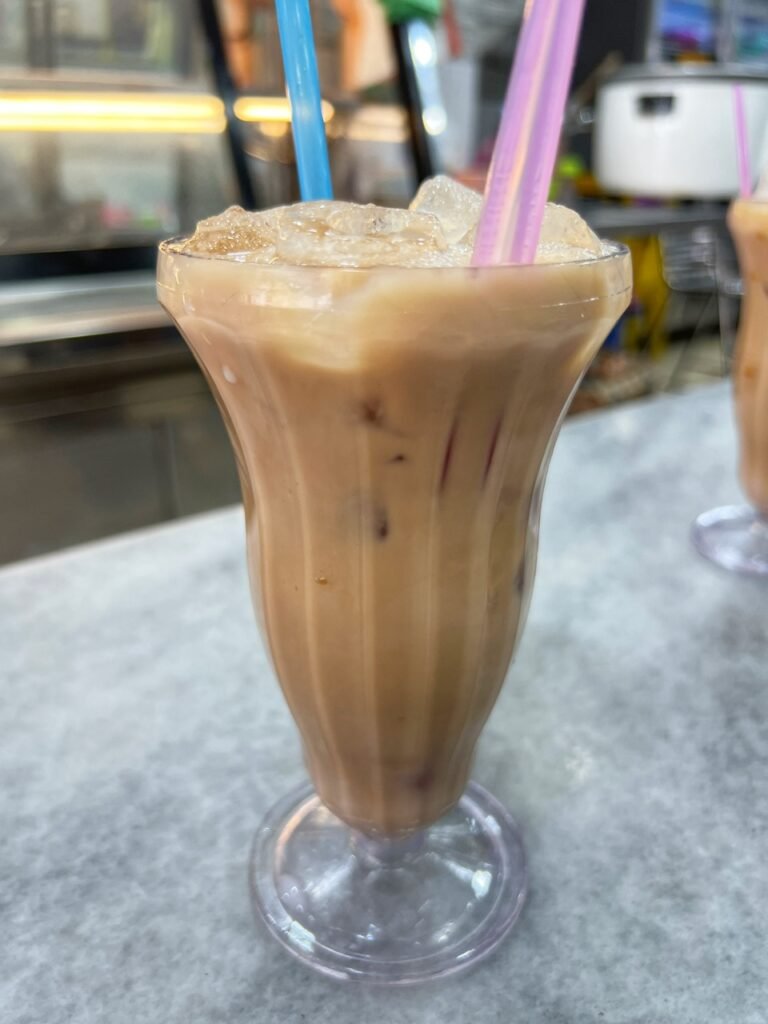

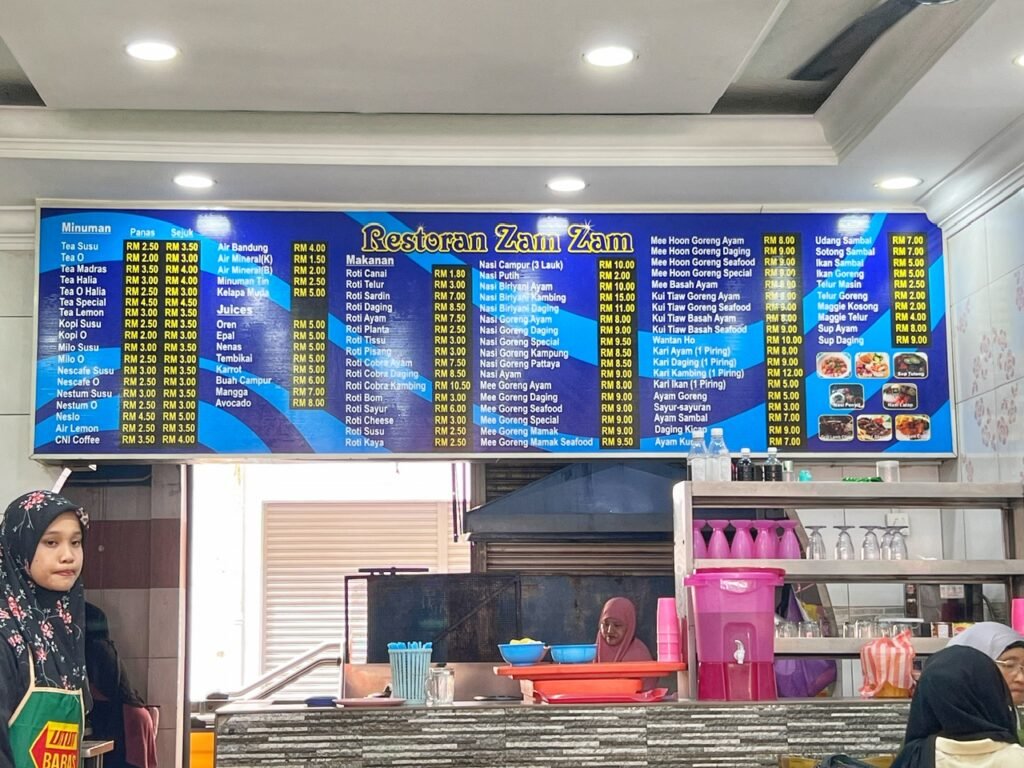
Ah well, at least they have good ‘ol reliable iced milk tea, which still tastes so good in this climate. Kui Tlaw Goreng Ayam, or chicken fried noodles for about $1.50.
The menus are basically a giant and overwhelming list of different ways to prepare rice (nasi) and (mie) noodle dishes. Many of them don’t entirely translate so it’s important to at least learn the word for what you don’t want and then try a little menu roulette.
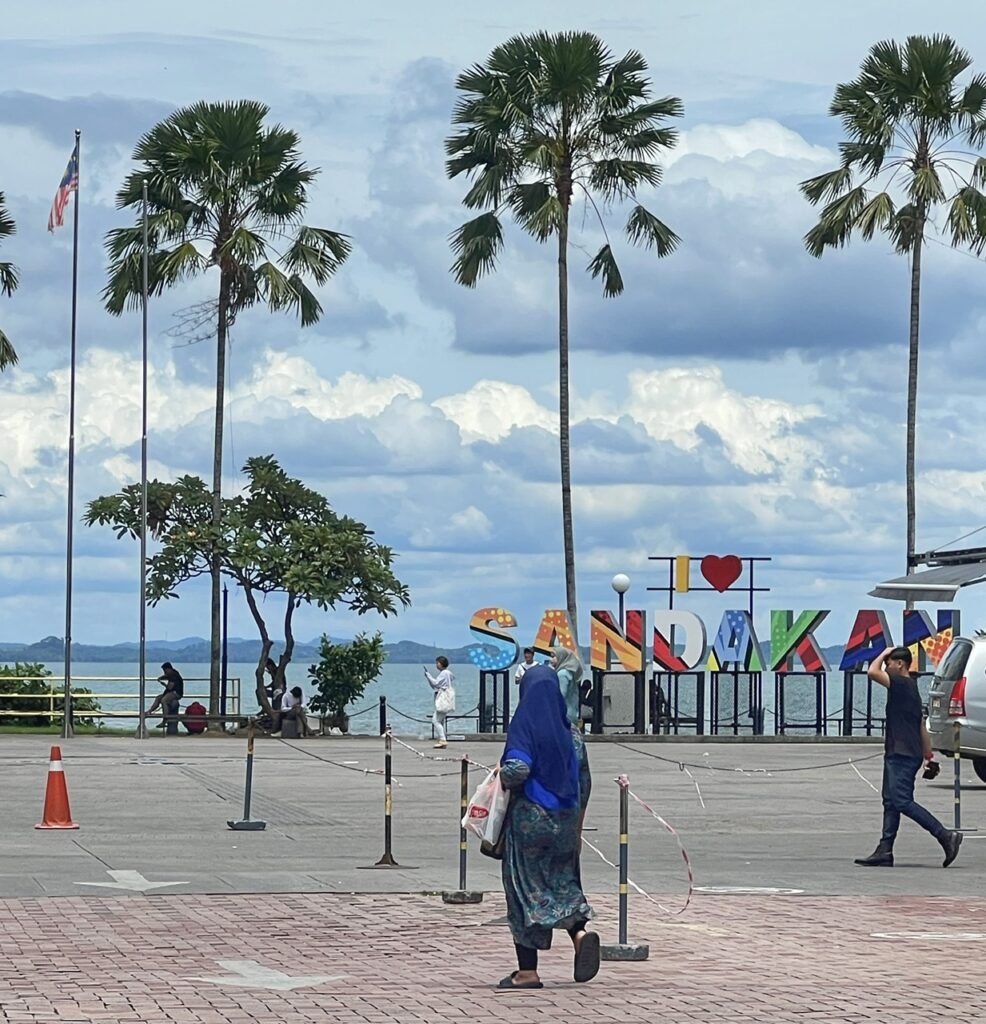
You know Sandakan is trying when you see they have Instagram signage.
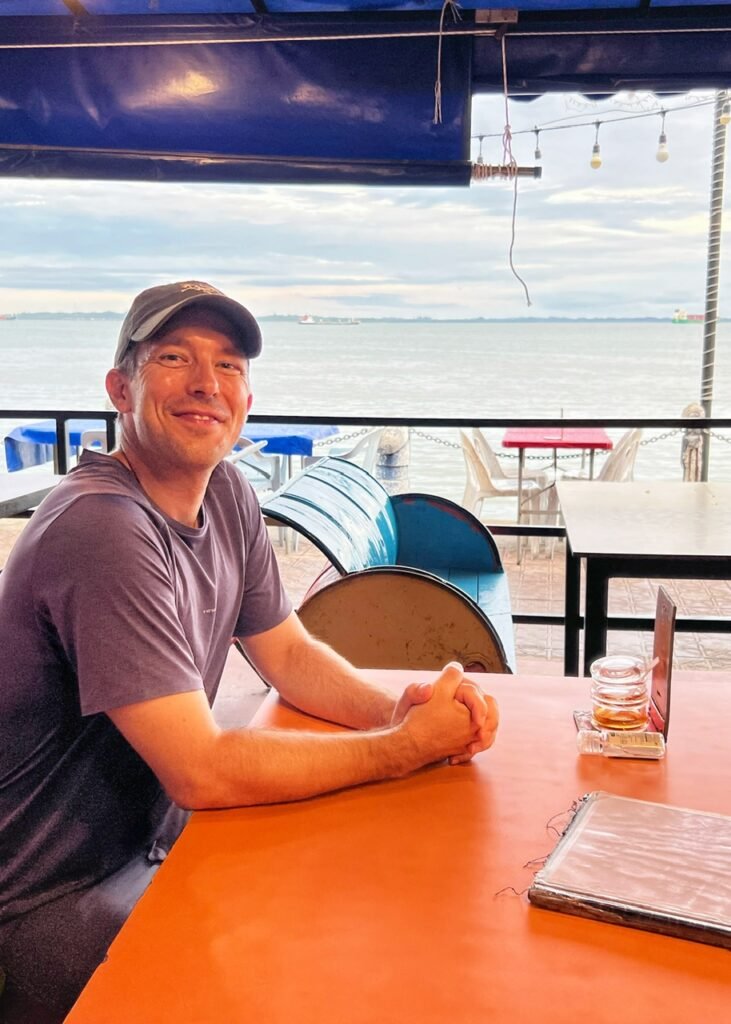
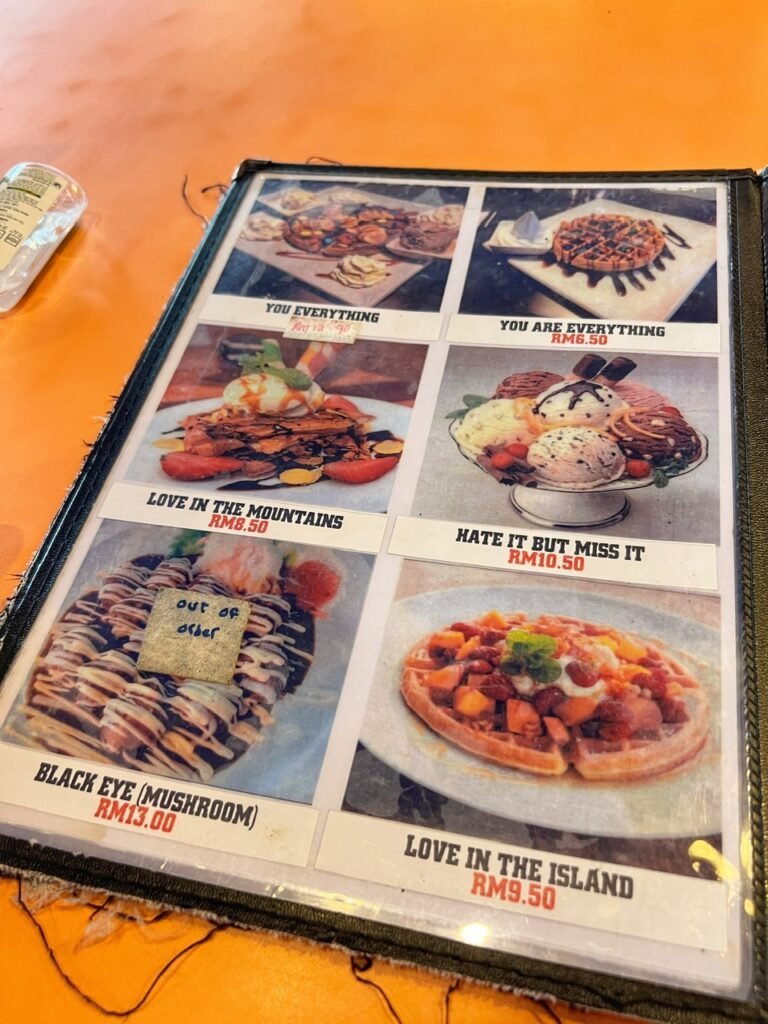
Grabbing dinner at D’Beach which did have a nice setting, and a wide selection of sugar for $1-2.


Mandy grabbed a “Rainbow Coconut” drink which only exhibited signs of rainbow by the orange jellies floating inside. It desperately needed rum and a little umbrella to complete its look. Also, because the waiter put both dishes in front of her and brought one set of silverware, she also thought these dishes were both hers and ate more than half before we realized one was supposed to be Greg’s. Oops. He got a pile of chocolate ice cream for his misfortune and really suffered.
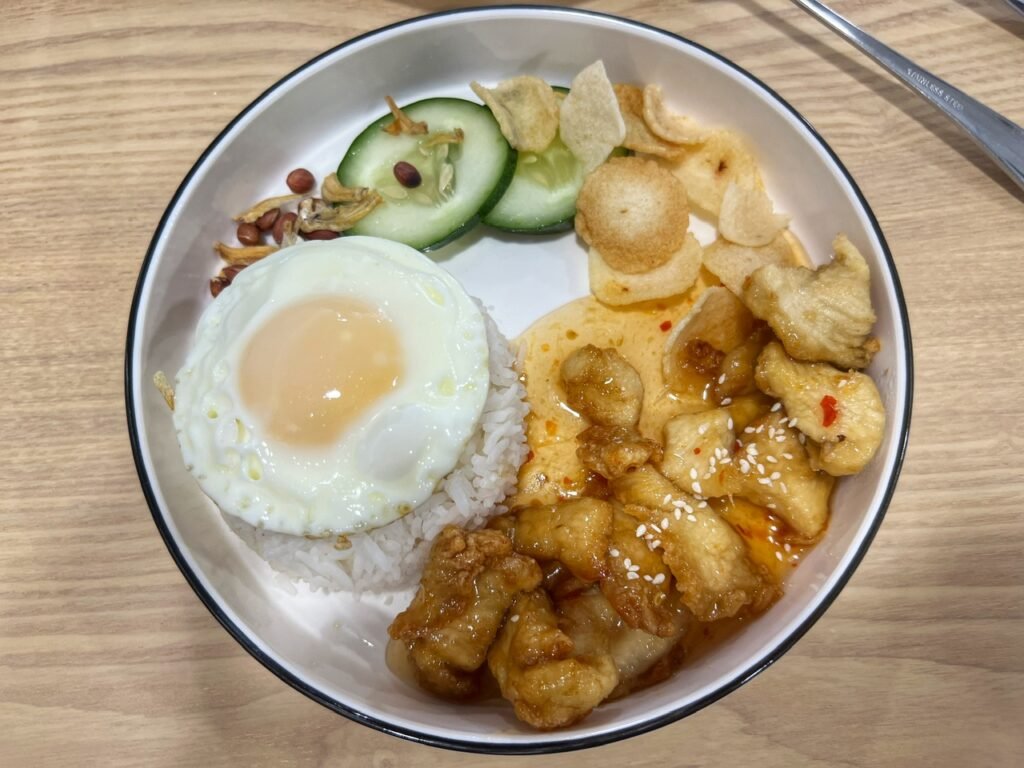

Another meal was Thai chicken which basically tasted like chicken with cheap sweet and sour sauce dumped on it. Ok. So we didn’t find the same value as in Kuching or Miri. Ooo! But did find soft serve COFFEE ice cream! Now we’re talking!

It didn’t take us long to want out of Sandakan. And unfortunately “Kiblat” does not mean emergency exit as Greg once thought of the signage posted to the ceiling of every hotel room. Since this one pointed directly to the corner, it became evident it was probably pointing to Mecca instead. So perhaps an emergency exit for some…but not us. 🤣
The Sandakan Heritage Trail and Agnes Keith House
We had actually never heard of the great American author, Agnes Newton Keith who lived in Sandakan and was best known for her three no autobiographical accounts of life on this island before, during, and after World War II. These books also tell of her time in a Japanese prisoner of war camp and visiting her house was quite an insight into what life was like in British Borneo at that time.
To get there we took the Sandakan Heritage Trail, which was again a very nice idea that the city had but it was in definite disrepair, unkept and a bit sketchy feeling in places mostly due to very sad and troubled looking street dogs. Many of the reviews on Google say not to walk here alone, which was again, such a different vibe than we’d gotten in Kuching or Miri.
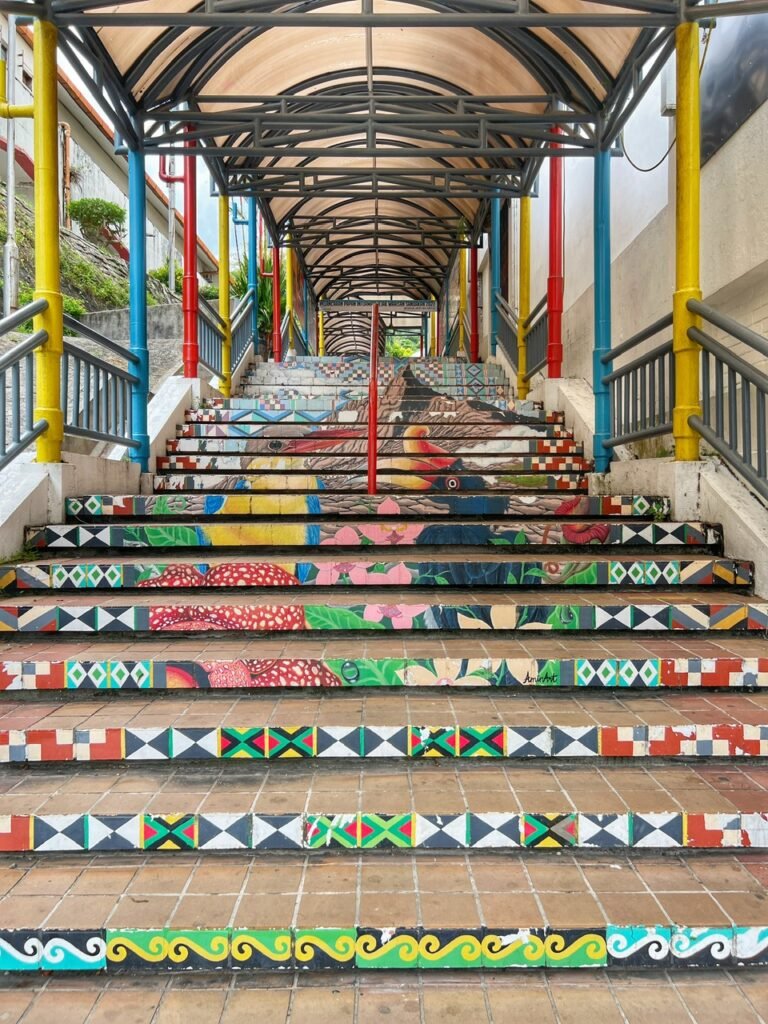
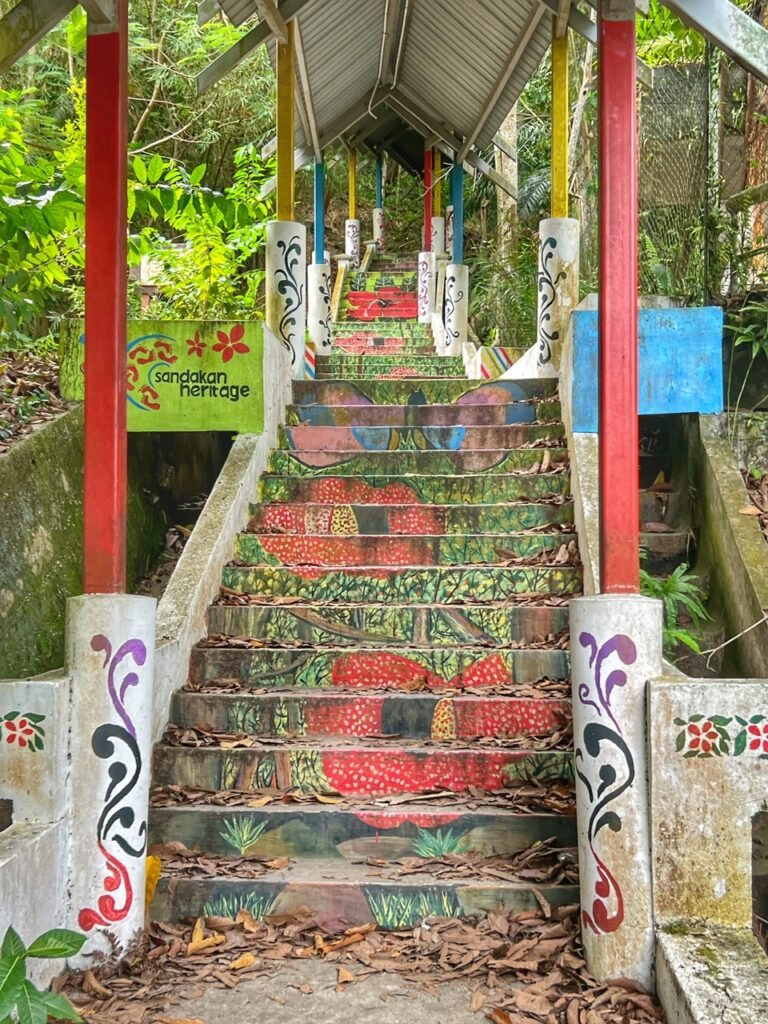
The Heritage Trail begins at a colorful muraled set of stairs leading up to a 1.5 hour loop of historic sites. We started later in the day due to the heat so didn’t get to do it all, but we got a taste.
It started with “100 steps” which was definitely at least double that to make sure you got your clothes nice and damp for the true equatorial experience.


The William Pryer Monument is dedicated to the British founder of Sandakan in 1879. He was the first resident of British North Borneo Chartered Company established in 1881. Sandakan was the pre-war capital until it was almost totally destroyed at the end of WW2. After all those steps, you do get rewarded with some nice eye candy of the bay.
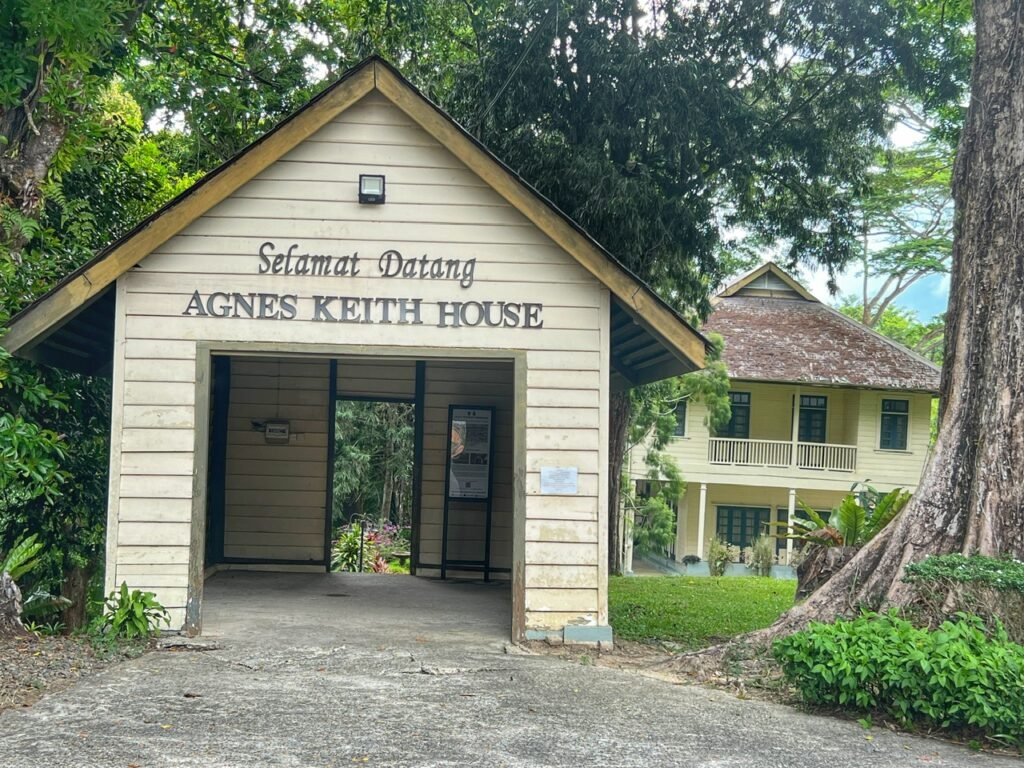
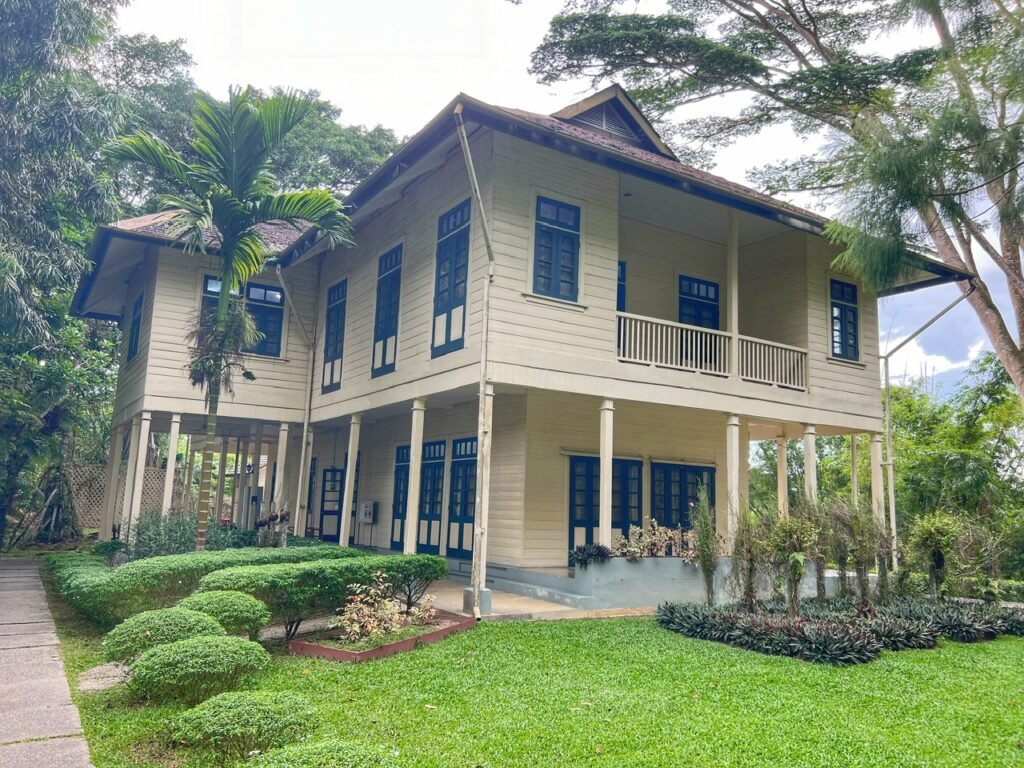
Arriving to Agnes Keith’s house, which was made into a museum and used to honor her in a Hollywood movie in 1950. As you can imagine, this elegant house, which looks nothing like anything else in Borneo, was quite talked about in 1934 when she and her husband, Henry George Keith, the Conservator of Forests for North Borneo, moved in.
According to her book, “White Man Returns,” trippers on world boats even came up to see it, carrying their camera and calling, “Why look! It’s just like a real house!” Young Chinese from the town climb up the hill and stand proudly by the front entrance to have their pictures taken to send back to China, call themselves resplendent against this splendid, anonymous backdrop of prosperity.”
So, basically…we concluded…the Chinese haven’t changed in a 100 years. 🤣
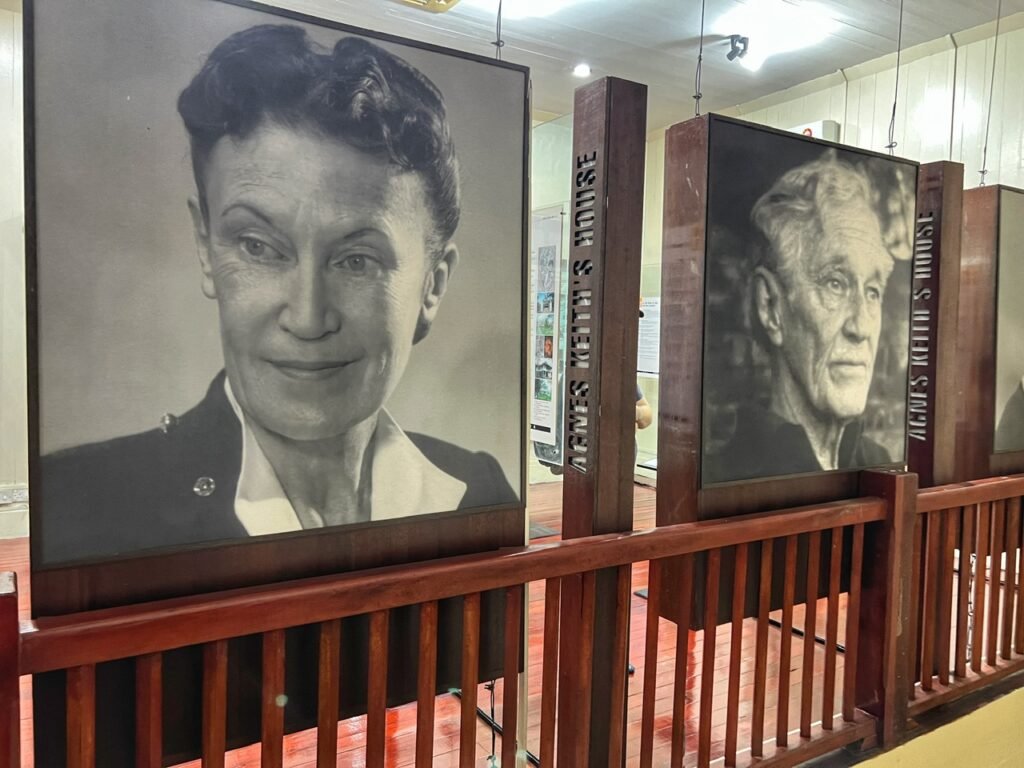
Photographs of Agnes and her husband. When Agnes Newton Keith sailed to Sandakan in 1934, she found that she was the only American woman among the 20 European ladies within an expat community of 70. She found life there very “British” and felt left out, “I wasn’t pregnant, I didn’t speak English, my spelling was Webster, there wasn’t any housework, wives didn’t take jobs in those days, golf made me hot, bridge made me cross…” (Bare Feet in the Palace, 1955).
But she was fascinated by the new country and began to write about it. Eventually she sent an article to the Atlantic Monthly magazine in the United States which was received enthusiastically. She was encouraged to write more of her life as the wife of a government official in this British colony of North Borneo. All her material were then incorporated into a book Land Below the Wind and entered for the magazine’s annual nonfiction prize in 1939. She won the top prize, netting her $5,000.00.


The original house was destroyed during the Japanese occupation. After the war, their home was reconstructed on the foundations of their first house, amongst the overgrown gardens and ruins. This was the first permanent timber house built by the British Government after the War. And the tropical hardwood floors, were simply drool-worthy!
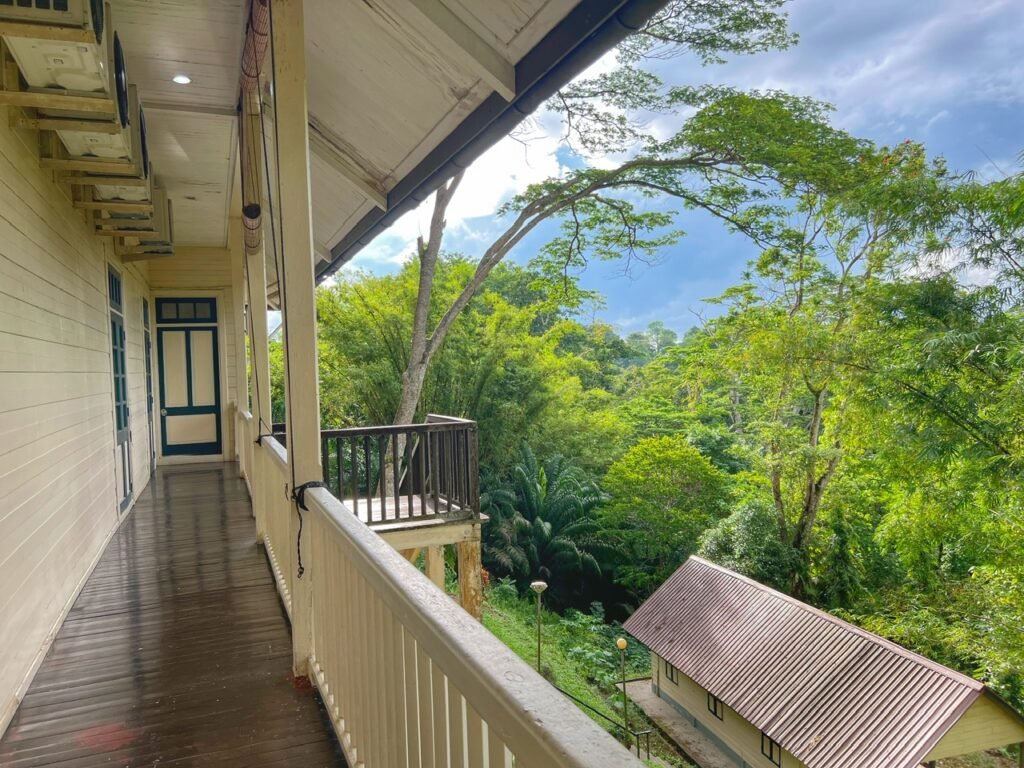
The back balcony looking into the jungle. There was undoubtedly more of it back then.
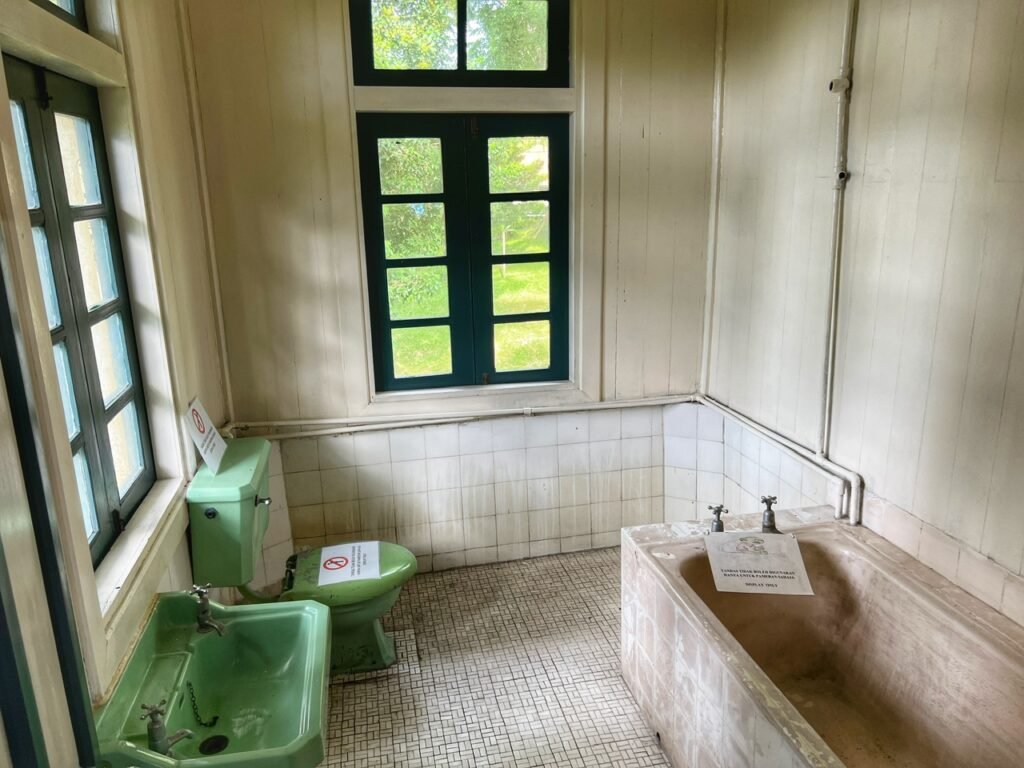
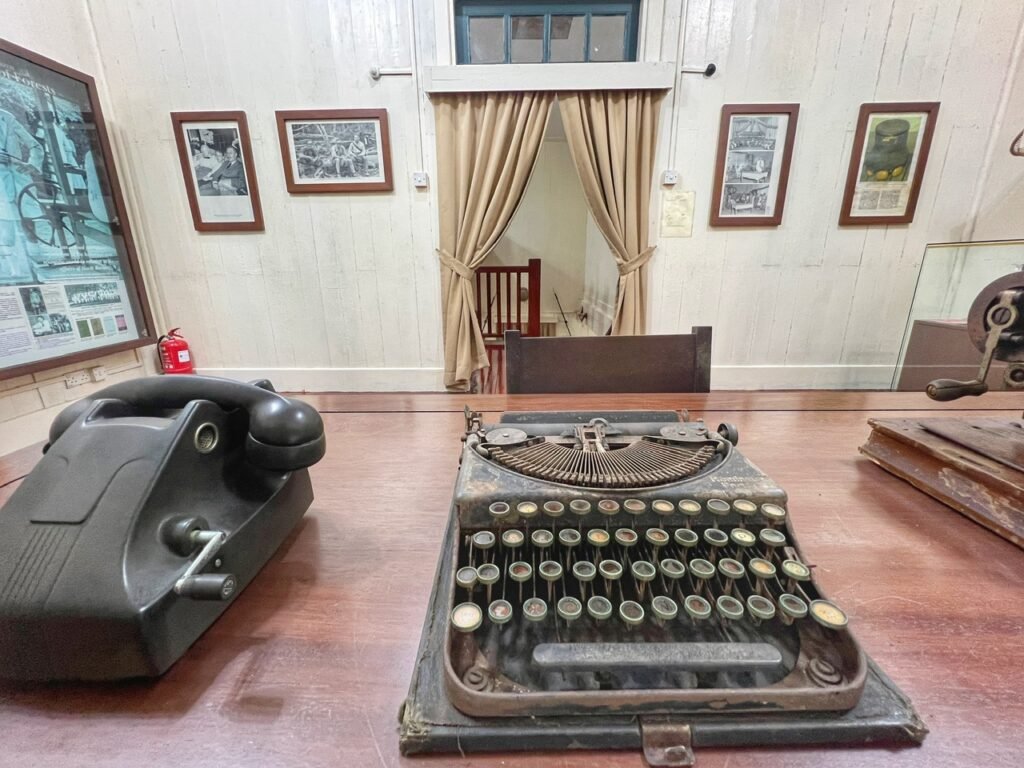
1940s bathroom fixtures…where the magic happened until they left in 1952.
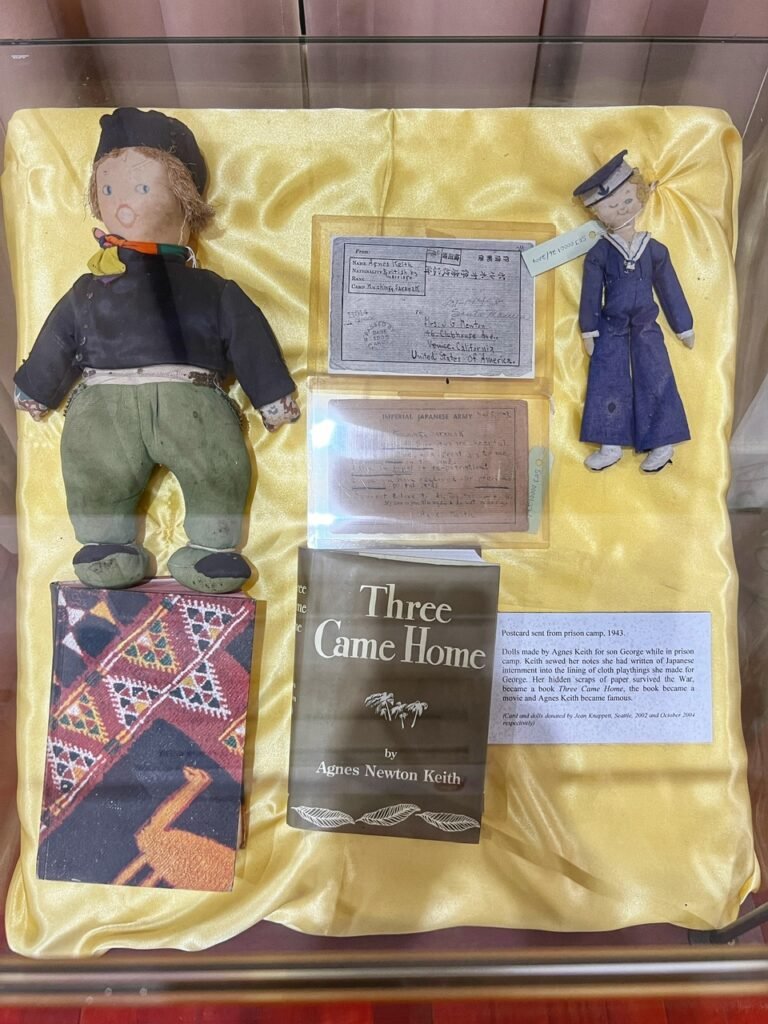
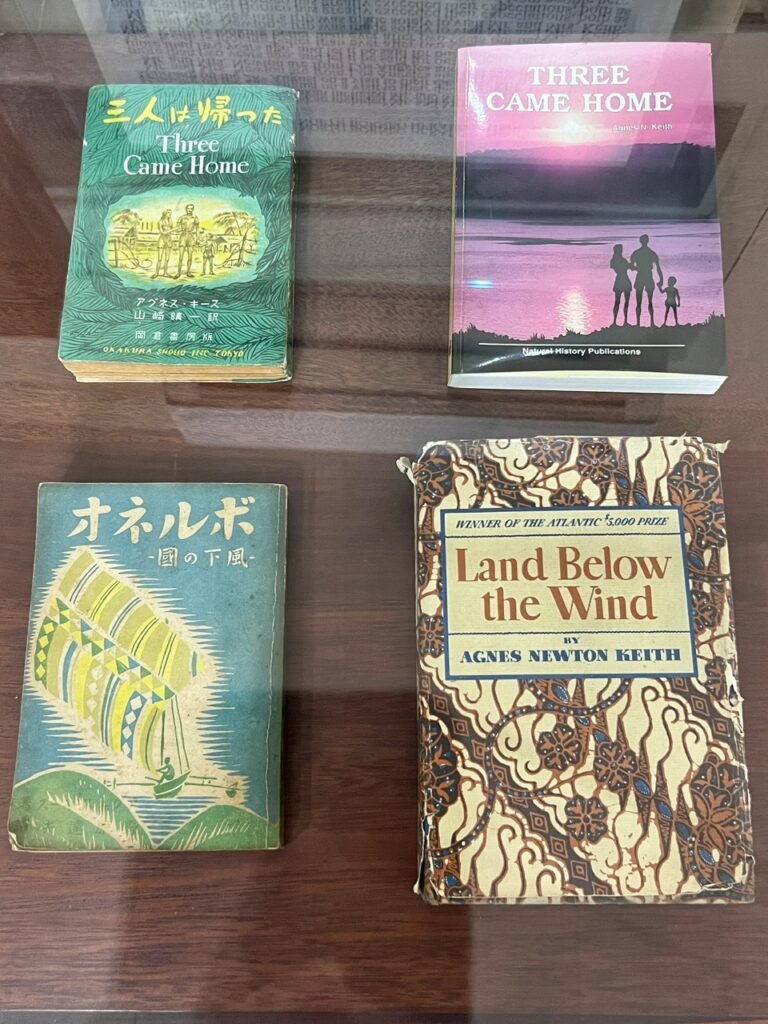
The magic, in reality happened everywhere, even from prison. Agnes would find pieces of paper, write on them and then sew them into the dolls she was making for her son to keep her future works from being confiscated. The story “Three Came Home” is about this time and with its movie, launched Ms. Keith to fame.
It definitely made us want to pick up one of these books. Has anyone read her work?
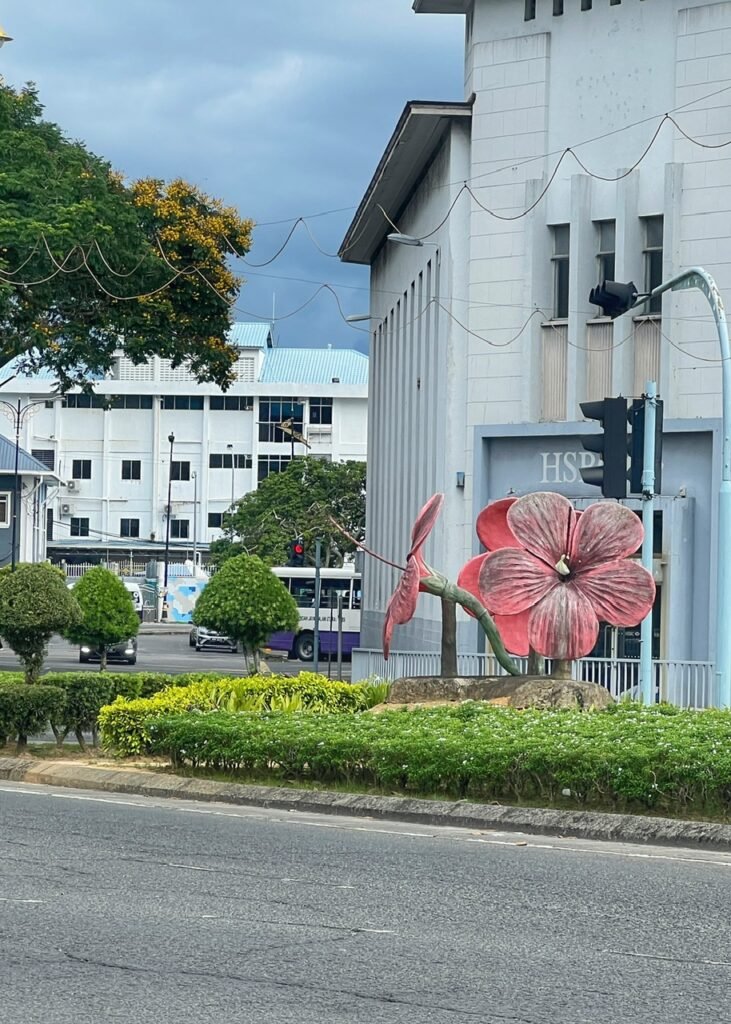
In 1984, the world’s largest flower, Rafflesia Keithii, was named after Henry George Keith. It’s very common to see statues of it in roundabouts in Sabah. We wish we’d be able to see it in the wild but it’s very difficult to time. P.s. As I finished writing this caption, I realized that’s actually a hibiscus. Ah, well. You get the idea. 🤣🙈

